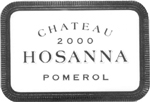
(previously known as Certan-Giraud)
Owner: Ets Jean-Pierre Moueix
Address: 33500 Pomerol
Mailing address: c/o SA Ets Jean-Pierre Moueix, BP 129, 54, quai du Priourat, 33502 Libourne
Telephone: 05 57 51 78 96; Telefax: 05 57 51 79 79
Visits: By appointment and exclusively for professionals of the wine trade dealing with the firm.
Contact: Frédéric Lospied
Surface area: 24.6 acres
Grape varietals: 71% Merlot, 29% Cabernet Franc
Average age of vines: 40 years
Density of plantation: 7,000 vines per hectare
Average yields: 35 hectoliters per hectare
Elevage: Twenty day fermentation and maceration in temperature-controlled concrete tanks. Eighteen months aging in barrels with 50% new oak. Fining, no filtration.
WINES PRODUCED
Château Hosanna: 18,000 bottles
Plateau of maturity: Within 5–15 years of the vintage
GENERAL APPRECIATION
While this estate has a reputation for irregular quality when known as Certan-Giraud, it offers one of the finest Pomerols since its acquisition by the Jean-Pierre Moueix firm of Libourne. In the capable hands of talented Christian Moueix, who apparently spares no effort to push the envelope of quality as high as possible, Hosanna is meant to compete with the trendy new-style Pomerols like Clos l’Église. The wine produced is all at once generous, rich, structured, with a little touch of sur-maturité (a trait common to many topflight Pomerols). The results to date have been splendid.
This property, planted with 71% Merlot and 29% Cabernet Franc, well situated on the plateau of Pomerol, was acquired in 1998 by the Jean-Pierre Moueix firm, and it is now one of their stars. The vineyard, planted with 35- to 40-year-old vines, is sandwiched between such superstars as Pétrus, Lafleur, Vieux Château Certan, and the balance of the former Certan-Giraud vineyard, now called Certan Marzelle. In the past, the wine has been good, but there was little selection and yields were simply too high to produce superb wine. That has obviously changed (dramatically) with the 1999 vintage, when the name of Certan-Giraud was changed to Hosanna.
The wine is now an extraordinarily elegant Pomerol made from blend of 80% Merlot and the rest Cabernet Franc. Based on the first three vintages, Hosanna comes closest in aroma, taste, and texture to a hypothetical blend of Cheval Blanc and L’Evangile, both only about one mile away.
IMPORTANT VINTAGES
HOSANNA
2001 |
A blend of 80% Merlot and 20% Cabernet Franc, the 2001 possesses an undeniable character that mirrors the personality of its nearby neighbor, Cheval Blanc. A complex perfume of blueberries, licorice, and black currants is both intense and captivating. Sweet, ripe, and layered on the attack with a serious mid-palate and stunning depth, the old vines give this Pomerol a delicious, deep, textured feel in the mouth. Hosanna is a topflight success in 2001. Anticipated maturity: 2005–2016. Last tasted, 1/03. |
Produced from 70% Merlot and 30% Cabernet Franc, this offering has evolved spectacularly well. Its deep saturated ruby/purple color is followed by aromas of incense, minerals, blackberries, and cassis with hints of licorice, truffles, and new oak. A seamless, seductive Pomerol displaying both power and charm, it is totally different than its predecessors made under the Certan-Giraud administration. This brilliant effort should age graciously for two decades. This is a ravishing wine of exceptional symmetry. Anticipated maturity: 2005–2020. Last tasted, 1/03. |
|
1999 |
A star of the vintage, this sexy, lush, complex, perfumed Pomerol exhibits a saturated ruby/purple color as well as a knockout nose of black fruits intermixed with menthol, saddle leather, licorice, and minerals. It is fleshy, silky, and voluptuous in its elegant, feminine style. Anticipated maturity: now–2016. Last tasted, 3/02. |
CERTAN-GIRAUD
1996 |
I noticed some sample variation with this wine, but in the majority of tastings, it was a dense, low-acid, fat, ripe Pomerol with a touch of prunes, jammy black cherries, smoke, and dried herbs in its smoky, ripe, flamboyant nose. Plump, succulent, medium- to full-bodied flavors are forward for the vintage, but appealing and delicious. Anticipated maturity: now–2007. Last tasted, 3/98. |
1995 |
The 1995 has turned out to be a very good Pomerol with sweet, jammy flavors that border on overripeness. The wine displays a deep ruby color with a flamboyant nose of smoke and black fruits. There is noticeable glycerin on the palate, medium to full body, low acidity, and plenty of power, intensity, and richness in this big, fleshy, mouth-filling, savory, hedonistic Pomerol. Anticipated maturity: now–2009. Last tasted, 11/97. |
ANCIENT VINTAGES
In the early 1990s or 1980s, the only vintage of merit was the 1982, which was still going strong when last tasted (88 points; last tasted 10/02).
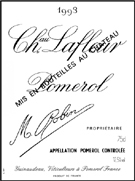
Owner: Jacques Guinaudeau and family
Address: 33500 Pomerol
Mailing address: Château Grand Village—33240 Mouillac
Telephone: 05 57 84 44 03; Telefax: 05 57 84 83 31
Visits: By appointment only
Contact: Sylvie and Jacques Guinaudeau
VINEYARDS
Surface area: 11.1 acres
Grape varietals: 50% Cabernet Franc, 50% Merlot
Average age of vines: More than 30 years
Density of plantation: 5,900 vines per hectare
Average yields: 38 hectoliters per hectare
Elevage: Fermentations and macerations last 15–21 days depending upon the vintage. Wines are transferred directly into oak barrels for malolactics, where they remain for 18–20 months in cask (one-third to one-half new oak). Wines are fined with fresh egg whites but not systematically filtered.
WINES PRODUCED
Château Lafleur: 12,000 bottles
Les Pensées de Lafleur: 3,000 bottles
Plateau of maturity: Within 8–40 years of the vintage
GENERAL APPRECIATION
Along with Pétrus, it is a titan of Pomerol as well as one of Bordeaux’s most prodigious wines. It is rarer than Pétrus and often just as expensive.
I have always had a personal attachment to this tiny Pomerol vineyard. In the mid-1970s, when I first started tasting the wines of Lafleur, I could find nothing written about them. Yet in my small tasting group we frequently found the wine to be every bit as compelling as Pétrus. I made my first visit to Lafleur in 1978, speaking very little French, and found the two elderly proprietors, now deceased, sisters Thérèse and Marie Robin, decrepit, but even then both were utterly charming. The Lafleur château was, and remains today, more of a barn than a winery. Despite the advanced age of these two spinsters, they would ride their bikes out to Le Gay, the official reception center for both Lafleur and Le Gay, on my visits in the late 1970s. They were no doubt amused by my size, referring to me as Monsieur Le Taureau (Bull). I probably did look a bit oversized walking in the tiny chai, where the barrels, as well as a bevy of ducks, chickens, and rabbits, were housed. It always amazed me how wines of such great extraction and utterly mind-blowing character could be produced in such filthy conditions.
Today Lafleur is both owned and managed by the niece and nephew, Sylvie and Jacques Guinaudeau. They took responsibility starting with the 1985 vintage and purchased it in 2002. One of their first decisions was to refuse to bottle any 1987 Lafleur. At the same time they introduced a second wine, Les Pensées de Lafleur. This is rather remarkable given the tiny production of this micro-estate. The cellars remain the same, but they are now devoid of ducks, chickens, and rabbits, as well as the dung they left behind. Additionally, Lafleur now benefits from at least 50% or more new oak casks for each vintage.
Is the wine any better? Certainly Lafleur remains one of the few wines of Pomerol that is consistently capable of challenging, and in some cases surpassing, Pétrus. Even the late Jean-Pierre Moueix once admitted this to me, and I have been fortunate to have had Lafleur and Pétrus side by side enough times to know the former is a wine every bit as extraordinary as Pétrus. In many vintages, from an aromatic point of view, it is more complex than Pétrus, no doubt because of the old vine Cabernet Franc the vineyard possesses.
Much of the greatness of Lafleur lies in the soil, which is a deep, gravelly bed enriched with iron and some sand but also characterized by extremely important deposits of phosphorus and potassium. Over the years the yields have been tiny, reflecting the motto of the Robin sisters’ father: “Quality surpasses quantity.”
Old vintages of Lafleur are legendary, but the history of the property has not been without mixed results. The 1971 and 1970 should have been better, and more recently, the 1981 is flawed by the presence of fecal aromas. However, the wine is now being looked over by an oenologist, and even though the old vines (there was no replanting at Lafleur after the freeze of 1956) are having to be grubbed up, the average age is still impressive. Since 1982 (the 1982 and 1983 were made by Christian Moueix and his ultra-conservative oenologist Jean-Claude Berrouet) Lafleur has become less exotic and perhaps more influenced by modern-day oenologists and their obsession with wines that fall within certain technical parameters. Nevertheless, Lafleur, measured by the highest standards of Bordeaux, while now made within proper technical parameters, still remains one of the most distinctive, most exotic, and greatest wines—not only from Pomerol, but in the world.
IMPORTANT VINTAGES
ANCIENT VINTAGES
Lafleur’s track record in the early 1970s was relatively disappointing, with a light, herbal, thin 1971 and an extremely irregular 1970 that, from the best bottles, could merit an upper-80-point score but nothing better. The three great vintages of the 1960s were the 1966 (96 points; last tasted 12/99), 1962 (91 points; last tasted 12/96), and 1961 (98 points; last tasted 12/95). The 1961 Lafleur was actually appallingly bad out of several bottles, but from well-kept bottles, or those from selected barrels, as I am sure the wine was bottled barrel by barrel, the wine is prodigious.
The 1959 (rated 88 in 12/87) is a ruggedly built, muscular, tough-textured wine that is impressive for its size and weight. But much like the 1964 and 1970, it lacks charm and finesse. It should continue to age well for another 10–15 years. I have always preferred the 1955 (rated 92 in 12/87). It possesses that exotic, mineral, black fruit character so typical of Lafleur, massive weight, an unctuous texture, and plenty of hard tannin still left in the finish.
Perhaps the greatest-kept secret in all of Bordeaux is how spectacular the 1950 vintage was in Pomerol. The 1950 Lafleur (100 points; last tasted 10/94) could easily pass for a 1947 or 1945 wine given its extraordinary level of concentration. The color remains black/purple, and the bouquet offers aromas of cedar, spices, and black fruits. The wine is unbelievably concentrated, massively full and rich, with sweet tannin in the finish. With a viscous, chewy texture, this pure wine could easily last for another 15–20 years. The 1949 Lafleur (96+ points; last tasted 10/94) offers a saturated purple/garnet color followed by a reluctant nose that, with coaxing, reveals intense, pure, cherry, jammy aromas intermingled with scents of minerals and licorice. Sensationally concentrated, with layers of thick, rich fruit and high tannin, this sweet, remarkably youthful wine is still not fully mature! It will last for another 20–30 years. There were many 1947s bottled in Belgium. I have had the 1947 Lafleur Belgian bottling, which ranges from very good to occasionally outstanding. As good as it is, the château bottling, from which this tasting note emanates, can leave you speechless. This is an extraordinarily profound wine that surpasses Pétrus and Cheval Blanc in this vintage, even though they can all be perfect wines. The 1947 Lafleur (100 points; last tasted 10/94) is more developed and forward than the 1949 and 1945. It reveals a thick, Port-like color with slight amber at the edge. The nose offers a smorgasbord of aromas, ranging from caramel to jammy black raspberries and cherries, honeyed nuts, chocolate, and truffles. The wine’s unctuousness and viscosity are unequaled in any other dry wine I have tasted. There is neither volatile acidity nor residual sugar present, something that many of the greatest 1947s possess. This wine’s richness and freshness are unbelievable. The finish, which lasts more than a minute, coats the mouth with layers of concentrated fruit. There have been many great Lafleurs, but the 1947 is the quintessential expression of this tiny yet marvelous vineyard that was ignored by wine critics for most of the 20th century. To date, it is the only wine that has ever brought me to tears! Similar to the 1947 Lafleur in aromatic complexity and flavor, richness, and textural thickness, the 1945 (100 points; last tasted 10/94) is blacker in color, less evolved, and possesses a more classic structural profile than the Port-like 1947. The 1945 tastes young, yet astonishingly unctuous, rich, and powerful. It will easily last for another 40–50 years. Will the 1975 turn out to be this memorable?
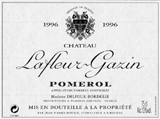
Owner: Nicole Delfour-Borderie
Farmer: Ets Jean-Pierre Moueix
Address: 33500 Pomerol
Mailing address: c/o SA Ets Jean-Pierre Moueix, BP 129, 54, quai du Priourat, 33502 Libourne
Telephone: 05 57 51 78 96; Telefax: 05 57 51 79 79
Visits: By appointment and exclusively for professionals of the wine trade dealing with the firm.
Contact: Frédéric Lospied
VINEYARDS
Surface area: 21 acres
Grape varietals: 80% Merlot, 20% Cabernet Franc
Average age of vines: 30 years
Density of plantation: 6,000 vines per hectare
Average yields: 45 hectoliters per hectare
Elevage: Eighteen day fermentation and maceration in temperature-controlled concrete tanks. Twenty months aging in barrels with 25% new oak. Fining, no filtration.
WINES PRODUCED
Château Lafleur-Gazin: 36,000 bottles
Plateau of maturity: Within 5–12 years of the vintage
GENERAL APPRECIATION
I am surprised that this estate, which benefits from a superb situation, does not produce better wines. Lafleur-Gazin is generally pleasant, supple, and fruity, but consistently lacking in stuffing and complexity.
Lafleur-Gazin is situated between the two estates of Gazin and Lafleur. The wine is produced by the firm of Jean-Pierre Moueix, which farms this property under a lease arrangement. The wine is supple, round, and straightforward in style. Given the vineyard’s location, it remains perplexing that the wines are so simple and light.
IMPORTANT VINTAGES
2001 |
The medium-bodied 2001 exhibits notes of prunes, plums, black cherries, and damp earth, good ripeness, spice, and moderate tannin in the finish. Anticipated maturity: 2004–2012. Last tasted, 1/03. |
2000 |
A sweet, superficial, but attractive effort, the 2000 Lafleur-Gazin reveals chalky tannin in the finish. A dark ruby/purple color is accompanied by ripe plum, prune, and berry fruit, medium body, and plenty of structure as well as tough tannin. Anticipated maturity: now–2014. Last tasted, 1/03. |
1999 |
Plums, figs, sweet cherries, and underbrush emerge from this soft, supple, garnet-colored wine. Round, cleanly made, and medium bodied with unobtrusive tannin and acidity, it will drink well for 8–9 years. Last tasted, 3/02. |
1998 |
One of the sleepers of the vintage, this is the finest Lafleur-Gazin I have tasted in many years. The wine is deep ruby/plum/purple–colored with a sweet, sexy bouquet of overripe black cherries, kirsch, smoke, and spice box. The seductive, fat, concentrated palate is open-knit and loaded with fruit, glycerin, and character. The acidity is low, the tannin ripe, and the finish succulent as well as velvety. Drink it over the next 12 years. Last tasted, 3/02. |
ANCIENT VINTAGES
Virtually nothing in the 1990s and 1980s elicited excitement, not even the 1982. A château to avoid when buying old vintages, and many young ones as well.
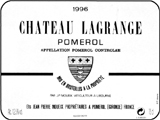
Owner: Ets Jean-Pierre Moueix
Address: 33500 Pomerol
Mailing address: c/o SA Ets Jean-Pierre Moueix, BP 129, 54, quai du Priourat, 33502 Libourne
Telephone: 05 57 51 78 96; Telefax: 05 57 51 79 79
Visits: By appointment and exclusively for professionals of the wine trade dealing with the firm.
Contact: Frédéric Lospied
VINEYARDS
Surface area: 11.6 acres
Grape varietals: 95% Merlot, 5% Cabernet Franc
Average age of vines: 30 years
Density of plantation: 6,250 vines per hectare
Average yields: 42 hectoliters per hectare
Elevage: Twenty day fermentation and maceration in temperature-controlled concrete tanks. Twenty months aging in barrels with 25% new oak. Fining, no filtration.
WINES PRODUCED
Château Lagrange: 24,000 bottles
Plateau of maturity: Within 5–12 years of the vintage
GENERAL APPRECIATION
Lagrange is not one of the best Pomerols. Generally robust, powerful, and tannic, it lacks finesse and complexity and is difficult to approach in its youth, which is unusual for a Merlot-based wine. I am surprised that this growth does not fare better in the hands of Christian Moueix and his team.
One rarely sees the wine of Lagrange. It is well situated near the plateau of Pomerol, but the vineyard has been recently replanted significantly, with the composition being changed to 95% Merlot and 5% Cabernet Franc. The wine tends to be a rather brawny, densely colored Pomerol, with significant power and tannins but not much complexity. Older vintages such as 1978, 1975, and 1970 have all proven to be stubbornly big, brooding, coarse wines that have been slow to develop. This is not a style of wine that I find attractive.
IMPORTANT VINTAGES
2000 |
A clone of the 1975, this dense plum/garnet–colored 2000 exhibits aromas of black fruits, truffles, licorice, and underbrush. However, the finish is all gritty tannin, raising the question of whether it will age gracefully. The wine has gained texture and fat during its élevage, so there is some hope for future harmony. Anticipated maturity: 2006–2020? Last tasted, 1/03. |
1999 |
Notes of prunes, fig, underbrush, and sweet cherry fruit emerge from this medium-bodied, soft Pomerol. The finish is tannic and austere. Consume it during its first decade of life. Last tasted, 3/02. |
1998 |
A dense ruby/purple color and sweet blackberry and cherry fruit can be found in this medium-to full-bodied, nicely concentrated wine. With power, moderate tannin, and good intensity, it should age well. Anticipated maturity: 2005–2015. Last tasted, 3/02. |
ANCIENT VINTAGES
Another property that has a mediocre track record. The only wines I ever found with some merit might include the 1995 (86 points; last tasted 11/97), 1990 (86 points; last tasted 1/93), and 1982 (85 points; last tasted 9/02).

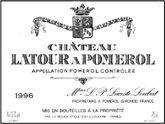
Owner: Foyer de Charité de Châteauneuf de Galaure
Farmer: Ets Jean-Pierre Moueix
Address: 33500 Pomerol
Mailing address: c/o SA Ets Jean-Pierre Moueix, BP 129, 54, quai du Priourat, 33502 Libourne
Telephone: 05 57 51 78 96; Telefax: 05 57 51 79 79
Visits: By appointment and exclusively for professionals of the wine trade dealing with the firm.
Contact: Frédéric Lospied
VINEYARDS
Surface area: 19.5 acres
Grape varietals: 90% Merlot, 10% Cabernet Franc
Average age of vines: 35 years
Density of plantation: 6,500 vines per hectare
Average yields: 40 hectoliters per hectare
Elevage: Twenty day fermentation and maceration in temperature-controlled concrete tanks. Twenty months aging in barrels that are renewed by a third at each vintage. Fining, no filtration.
WINES PRODUCED
Château Latour à Pomerol: 25,000–30,000 bottles
Plateau of maturity: Within 6–20 years of the vintage
GENERAL APPRECIATION
In the 1940s, 1950s, and 1960s, Latour à Pomerol was one of the most sumptuous Bordeaux. It then went through a difficult period, and during the following 30 years produced good wines (as opposed to great), with the exception of the superb 1982. In recent years, it has improved and now ranks amongst the top 20 or so Pomerols. In style, it is much closer now to Trotanoy or La Fleur-Pétrus than to Pétrus, to which it used to be compared during its glory days.
Latour à Pomerol produces splendidly dark-colored wines that usually represent a powerful, opulent, fleshy style of Pomerol. The vineyard is made up of two parcels. One is located near the church of Pomerol on a deep, gravelly bed. The second, the smaller parcel, is located farther west near RN 89 on sandier, lighter soil. The second parcel is closest to the vineyard owned by Christian Moueix called La Grave.
Latour à Pomerol can be majestic and, historically, was one of the two or three greatest wines of the appellation in certain vintages. The 1970, 1961, 1959, 1950, 1948, and 1947 offer persuasive evidence that this estate can rival the greatest wines of Bordeaux; except for the 1982, nothing in the last 30+ years even remotely recalls those legends. While some observers have claimed that Latour à Pomerol comes closest in weight and structure to Pétrus, that would not appear to be the case. This is a wine that, while rich and full, tends to have more in common with other Moueix-controlled properties such as Trotanoy than Pétrus.
Latour à Pomerol is usually about one-fifth the price of Pétrus and about one-half the price of Trotanoy and Lafleur. For a limited-production Pomerol of such high quality, it remains a relative bargain.
IMPORTANT VINTAGES
2001 |
This impeccably made blend of 85% Merlot and 15% Cabernet Franc exhibits an impressive dark ruby/purple color as well as a sweet, pure nose of black fruits intermixed with iron, dried herbs, and smoke. Layered, elegant, and well delineated, with fresh, vibrant fruit typical of the finest 2001s, it will be at its finest between 2005–2016. Last tasted, 1/03. |
2000 |
The 2000 has added weight as well as texture during its élevage. A saturated ruby color is followed by aromas of black cherries, caramel, truffles, and sweet earth. Textured and medium to full-bodied, with moderately high tannin (typical of Pomerol’s finest 2000s), it will require patience. Anticipated maturity: 2007–2019. Last tasted, 1/03. |
1999 |
This is an excellent, forward, complex Pomerol with creamy opulence on the mid-palate and a complex nose of cedar, licorice, plum, black cherries, and a hint of herbaceousness. The sweet, fleshy, sexy, seductive style will be popular with many tasters. Drink it over the next 12 years. Last tasted, 3/02. |
1998 |
A beautiful effort, the 1998 is, along with the 2000, one of the finest wines produced at this estate in the last 30 years. However, it is unlikely to turn out better than the 1982 or 1970. Revealing characteristics of vanilla, leather, highly extracted black cherry fruit, and caramel, this deep, rich, full-bodied, powerful, layered, sweetly tannic 1998 is not as profound as I originally thought, but it is still an outstanding wine. Anticipated maturity: 2006–2020. Last tasted, 3/02. |
1997 |
This type of wine will please many consumers, so readers should give it a try. A dark ruby color is followed by a deep, rich, excellent display of roasted nuts, jammy berry fruit, dried herbs, and tomato skins. It is seductive, lush, and medium to full-bodied, with impressive levels of glycerin, fruit, and intensity. Low acidity and a forward style suggest it is best consumed over the next 3–4 years, although it will undoubtedly last longer. Last tasted, 1/01. |
1996 |
This wine reveals a saturated dark ruby color and excellent blackberry and cherry aromas intermixed with toast, roasted nuts, and vanilla. Medium bodied with admirable concentration, moderate levels of spicy oak, and sweet tannin, this dense wine has been delicious since its prime and should hold until 2014. Last tasted, 3/01. |
1995 |
This might have a chance of hitting a magical outstanding score, as the wine still seems to be holding back much of its potential. A deep ruby/purple with a distinctive, very singular nose of wet steel, licorice, spice box, Provençal herbs, and roasted black fruits, as the wine hits the palate, there is generosity, ripeness, and purity, with sweet black fruits intermixed with cedar, earth, and some subtle herbs. Medium to full body and excellent richness are the hallmarks, but the wine’s tannic structure and level of astringency have kept my scores conservative. In any event, I am still waiting for this wine to emerge from behind its cloak of tannin, which is formidable. This could be a top effort for Latour à Pomerol if everything comes together. Anticipated maturity: 2007–2020. Last tasted, 1/02. |
Weediness and a slight shortness in the finish are the only flaws in an otherwise relatively good effort from Latour à Pomerol. The color is a deep, dark garnet with some amber at the edge. A big, spicy, sweet nose of black fruits, tobacco, espresso, and stewed roasted vegetables is followed by a relatively fat, ripe, medium-bodied wine with low acidity and some sweet tannins in the finish. Drink it over the next 5–7 years. Last tasted, 1/02. |
|
1990 |
I expected far greater things of this wine from cask. From bottle, the wine seems to have aged at a very accelerated pace, and it is now showing considerable amber at the edge of its garnet color. The wine shows a very complex nose of cedar, spice box, mocha, caramel, and sweet red and black currant fruit. The initial generosity and sweet fruit seems to dry out in the finish, with some hints of fig, dusty, loamy soil, and old wood. For the vintage and the vineyard, a disappointment. Anticipated maturity: now–2007. Last tasted, 1/02. |
1989 |
A very pleasant, medium-bodied, fleshy Pomerol. A fully mature nose of smoke, roasted vegetables, dried herbs, sweet currants, and caramel, with medium to full body on the attack, but some drying (even desiccating) tannins in the finish make for a very good but somewhat uninspiring effort from Latour à Pomerol. Anticipated maturity: now–2012. Last tasted, 1/02. |
1988 |
Licorice, Chinese black tea, dried herbs, and some plum and fig-like fruit as well as freshly ground pepper emerge from the complex aromatics of the dark garnet–colored 1988 Latour à Pomerol. In the mouth the wine shows good concentration and some sweetness, but a somewhat chunky, monolithic style with scratchy tannins in the finish. Drink it over the next 6–10 years. Last tasted, 1/02. |
1985 |
Sexier in its life, but again far less impressive from bottle than cask, the 1985 Latour à Pomerol shows considerable amber at the edge. Some sweet mulberry, cranberry, and cherry fruit is intermixed with fruitcake, cedar, and black tea notes. The wine is medium bodied and very elegant, with soft tannin in a modest finish. Drink it up. Anticipated maturity: now–2007. Last tasted, 1/02. |
1983 |
At one time a very delicious example, I made the mistake of holding on to the last bottles far too long. The wine has hit full maturity and now seems to be in decline. The color is a dark garnet with considerable amber at the edge. The nose shows some stewed notes of plums, prunes, caramel, chocolate, and vegetables. The wine still has some sweetness and plump fruit on the attack, but then narrows out and becomes a bit attenuated in the finish. It is starting to crack up and needs to be drunk up. Anticipated maturity: now. Last tasted, 12/00. |
1982 |
Fully mature and not likely to get any better, the 1982 has a medium garnet color with considerable amber at the edge. The wine shows a stunning nose of sweet caramel intermixed with jammy kirsch, spice box, vanilla, Asian spice, and licorice. Once past the fragrant, exuberant aromatics, the wine exhibits a medium-to full-bodied, plump, very opulent texture with sweet, concentrated fruit, low acidity, and very ripe tannin that is now seamlessly integrated in the wine’s personality. P.S.: The problem I had with half my case of wine being corked, four out of five bottles opened, has not reappeared in subsequent tastings . . . thankfully. Anticipated maturity: now–2012. Last tasted, 11/02. |
ANCIENT VINTAGES
Nothing in the 1970s was particularly interesting except for the fabulous 1970 (93 points; last tasted 6/96). This wine is fully mature yet is holding on to most of its character. Of course, few châteaux in Bordeaux have the kind of track record Latour à Pomerol produced in the late 1940s. One hundred point scores are certainly rare, but the 1961 (100 points; last tasted 12/96), 1959 (98 points; last tasted 12/00), 1950 (98 points; last tasted 3/97), 1948 (96 points; last tasted 3/96), and 1947 (100 points; last tasted 3/97) are legendary wines that make what’s going on today at Latour à Pomerol a mystery. All of these wines have extraordinary freshness and remarkable intensity, amazing color saturation, and voluminous, mouth-filling, highly concentrated styles, but all in balance. From well-kept bottles, drinking any of these vintages of Latour à Pomerol is one of the great wine drinking experiences of a lifetime.
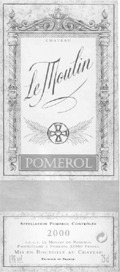
Owner: SCEA Le Moulin de Pomerol
Administrator: Michel Querre
Address: Moulin de Lavaud, La Patache, 33500 Pomerol
Mailing address: SCEA Le Moulin de Pomerol, BP 51, 33330 St.-Emilion
Telephone: 05 57 55 51 60; Telefax: 05 57 55 51 61
Visits: By appointment only
Contact: Michel Querre
VINEYARDS
Surface area: 5.9 acres
Grape varietals: 80% Merlot, 20% Cabernet Franc
Average age of vines: 35 years
Density of plantation: 5,400 vines per hectare
Average yields: 32 hectoliters per hectare
Elevage: Three to four week fermentation and maceration (with the skins) in temperature-controlled wooden vats of small capacity (20 and 25 hectoliters). Fifteen to twenty months aging in new oak barrels. Fining and filtration depend upon the vintage.
WINES PRODUCED
Château Le Moulin: 6,000 bottles
Le Petit Moulin: 1,000–2,000 bottles
Plateau of maturity: Within 4–15 years of the vintage
GENERAL APPRECIATION
Beginning with 1998, Le Moulin has considerably changed its winemaking style. This up-and-coming, small estate, which appears to prefer an exotic style of Pomerol, produces a Le Pin look-alike, made in a similar style, with extravagant, toasty new oak and ripe Merlot fruit. The wine generally offers flamboyant notes of caramel, mocha, and jammy berry/cherry fruit. The debut vintage, 1998, was a sensational effort, and the 1999, while not as outstanding, was savory and delicious. The superb 2000, which should rival the 1998, was followed by a compelling 2001. Wines produced prior to 1997 are of good quality, but not exceptional.
2001 |
Produced from ripe fruit, the 2001 Le Moulin exhibits obvious new oak in the ostentatious nose of jammy black fruits, incense, and smoke. Dense and medium to full-bodied, with low acidity and loads of glycerin, it is a sensual, hedonistic effort to enjoy during its first 10–14 years of life. Last tasted, 1/03. |
2000 |
Its flamboyant bouquet of roasted coffee, cherry liqueur, chocolate, and toasty oak is accompanied by a full-bodied, deep, luxuriously rich, powerful wine with more structure than the 1998, but similar length, concentration, and intensity. This is Pomerol at its most extravagant. Anticipated maturity: now–2016. Last tasted, 1/03. |
1999 |
An up-front, lush, exotic Pomerol with black raspberry liqueur and cassis notes presented in a sweet, soft, hedonistic style, the 1999 Le Moulin does not possess the concentration of the 1998 or 2000, but what’s there is savory and undeniably interesting and delicious. Drink it over the next 10 years. Last tasted, 3/02. |
1998 |
A hedonistic, exotic, creamy-textured effort, the 1998 exhibits gorgeous espresso, plum, raspberry, and cherry liqueur aromas as well as flavors. Medium to full-bodied and lush, it is best consumed over the next 10 years. Last tasted, 3/02. |
1997 |
A solid effort for the vintage, the 1997 Le Moulin possesses cherry/raspberry fruit, medium body, fine ripeness, no herbaceousness or sharpness, but a pinched finish. Its personality invites consumption over the next 1–2 years. Last tasted, 3/01. |
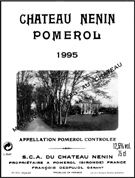
Owner: SCA Château Nenin (Delon family)
Address: Catusseau, 33500 Libourne
Telephone: 05 57 51 00 01; Telefax: 05 57 51 47 77 (estate)
Telephone: 05 56 73 25 26; Telefax: 05 56 59 18 33 (offices)
E-mail: leoville-las-cases@wanadoo.fr
Visits: By appointment only
Contact: Secretary’s office
VINEYARDS
Surface area: 61.8 acres
Grape varietals: 75% Cabernet Franc, 25% Merlot
Average age of vines: 28 years
Density of plantation: 6,250 vines per hectare
Average yields: 45 hectoliters per hectare
Elevage: Eighteen to twenty day fermentation and maceration in temperature-controlled stainless-steel vats. Eighteen months aging in barrels with 30% new oak and 70% one-year-old barrels. Fining, no filtration.
WINES PRODUCED
Château Nenin: Variable
Fugue de Nenin: Variable
Plateau of maturity: Within 5–20 years of the vintage
Long in the throes of mediocrity, Nenin has been resurrected under the ownership of the Delon family (of Las-Cases fame) and is quickly gaining ground as well as respect. Judging by what the Delons have accomplished with Léoville Las Cases in St.-Julien, I would not be surprised if Nenin were to improve further during the coming years. Since 1998, the estate has produced wines that are rich and generous. Nenin is expensive.
This is a historic estate of Pomerol, owned by the Despujol family between 1847 and 1997, when the property was sold to Michel and Jean-Hubert Delon, the proprietors of Léoville Las Cases. Obviously great things have been anticipated. Nenin has a loyal following of wine enthusiasts, but I have never been able to figure out why. I was certainly taken by a bottle of their 1947 I tasted in 1983 and an excellent 1975, but aside from those splendid wines I have always found Nenin to be good but unfortunately somewhat coarse and rustic.
Traditionally Nenin tends to be a firm, hard, chewy wine. Since 1976 the property has not performed well, turning out wines that have lacked intensity, character, and complexity. Were the yields too high? Did the decision to employ a mechanical harvester starting in 1982 negatively affect quality?
Now that this property has been acquired by the Delon family (proprietors of Léoville Las Cases) and Jean-Hubert Delon, has been put in charge, Nenin is quickly surging to the forefront of Pomerols.
IMPORTANT VINTAGES
2001 |
Made from low yields of 29 hectoliters per hectare, this blend of 70% Merlot and 30% Cabernet Franc is monolithic yet delineated in style. High tannin, considerable structure, a large size, and deep black fruit make for a sizable mouthful of wine. At present, it lacks charm and suppleness. It is a firmly styled Pomerol that should be at its finest between 2007–2020. Last tasted, 1/03. |
2000 |
This is the finest Nenin to yet emerge under the Delon ownership. A blend of 65% Merlot and 35% Cabernet Franc (high for Pomerol), the opaque purple–colored 2000 Nenin displays an unevolved but classic nose of sweet, jammy black fruits (primarily cherries and currants), licorice, underbrush, and subtle wood. Full-bodied with copious amounts of 1975-ish tannin and a long, structured, well-delineated finish, it will require significant patience. Anticipated maturity: 2009–2025. Last tasted, 1/03. |
1999 |
Nenin has fashioned a 1999 with elegance, structure, and outstanding purity. A dark ruby color is followed by a medium-weight Pomerol offering aromas and flavors of black fruits mixed with dried herbs, minerals, and oak. Anticipated maturity: 2006–2018. Last tasted, 3/02. |
1998 |
The finest Nenin in many decades, the dense ruby/purple–colored 1998 exhibits aromas of coffee, melted caramel, vanilla, plums, and black cherry jam. It is full-bodied with an unctuous texture, superb purity, and a silky, seamless finish. There is abundant tannin submerged beneath the wine’s fatness and richness. Anticipated maturity: 2004–2025. Last tasted, 3/02. |
1997 |
The Delons did not have control over the vineyard and entire vinification for this vintage, but they instituted a strict selection, resulting in an attractive, elegant, richly fruity wine with copious quantities of cherries and black currants presented in a lush, supple style. It should drink well for six years. Last tasted, 3/01. |
Prior to the acquisition of Nenin by the Delon family, the success record of this property in the 1980s and early 1990s was nonexistent. The wines were often mediocre, with even the 1982 a mid-70-point wine. The only wine that comes up on my scoring sheet as having merit is the 1975 (88 points; last tasted 3/01). That wine is probably still in good shape and no doubt inexpensive, given the reputation for mediocrity that ensued for the following 20 years.
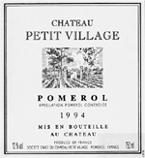
Owner: AXA Millésimes
Administrator: Christian Seely
Address: 33500 Pomerol
Telephone: 05 57 51 21 08; Telefax: 05 57 51 87 31
E-mail: infochato@petitvillage.com
Website: www.petit-village.com
Visits: By appointment only
Contact: Madame Malou Le Sommer, Chateau and Associes 33250 Pauillac
VINEYARDS
Surface area: 27.2 acres
Grape varietals: 65% Merlot, 18% Cabernet Sauvignon, 17% Cabernet Franc
Average age of vines: 35 years
Density of plantation: 5,600 vines per hectare
Average yields: 50 hectoliters per hectare
Elevage: Eighteen to thirty-five day fermentation and maceration in temperature-controlled stainless-steel vats. Completion of malolactics in barrel. Fifteen to eighteen months aging with 75% new oak and 25% one-year-old barrels. Fining, no filtration.
WINES PRODUCED
Château Petit Village: 42,000 bottles
Le Jardin de Petit Village: 15,600 bottles
Plateau of maturity: Within 5–12 years of the vintage
GENERAL APPRECIATION
While this estate has done well since 1982, its performance between 1991 and 1997 has been perplexing. Given the potential of the vineyard, Petit Village can do better. Its wines seem to lack the fruitiness, suppleness, and generosity they have exhibited in the past, but the most recent efforts have been reassuring.
Petit Village is a Pomerol estate on the move. In 1971, when Bruno Prats, also the dynamic owner of the famous Médoc estate of Cos d’Estournel, took over responsibility for the making of the wine, the quality increased dramatically. Petit Village had the benefit of significant capital investment, the care of a dedicated owner, and the state-of-the-art technology necessary for producing wine. The result was a succession of wines that ranged in quality from good to exceptional. In 1989, Prats sold Petit Village to an insurance conglomerate that installed Jean-Michel Cazes and his brilliant winemaking team, led by Daniel Llose, from Lynch-Bages as administrators. With the retirement of Cazes, Christian Seeley took over as manager. In 2002, a pending sale of Petit Village to St. Emilion’s Gerard Perse fell through.
The style of Petit Village emphasizes the toasty, smoky character of new oak barrels, a fat, supple, black currant fruitiness, and impeccably clean winemaking and handling. Recent vintages have the ability to age for 10–15 years, although they are fully ready to drink by age five or six. Older vintages (prior to 1982) have generally proven to be a disappointment, so wine enthusiasts are well advised to restrict their purchases to vintages since 1978.
It can be argued strongly that Petit Village has joined the top hierarchy of Pomerol estates and now ranks as one of the top 20 wines of the appellation. Certainly the vineyard is superbly situated. Bordered by Vieux Château Certan and Certan de May on the north, La Conseillante on the east, and Beauregard on the south, the vineyard has plenty of gravel as well as an iron-rich subsoil intermixed with deposits of clay. The high percentage of Merlot insures a rich, voluptuous wine in years when the Merlot reaches full maturity and yields are reasonable. Petit Village is a Pomerol to buy, as the price has not kept pace with its rejuvenated quality level.
IMPORTANT VINTAGES
2001 |
The opaque ruby/purple–colored 2001 is a low-acid, monolithic effort that tends toward flatness. However, the ripeness, juicy texture, and thick, lovely, black cherry and plum-like fruit are impressive. It needs to add more definition and complexity to merit a 90-point score, but it will certainly be in the upper 80s. Anticipated maturity: 2006–2015. Last tasted, 1/03. |
2000 |
The 200 is surple and surprisingly evolved. A medium-bodied, very savory wine, it exhibits a dense purple color along with a monolithic, deep, chewy personality offering notes of chocolate, black fruits, new oak, and earth. Anticipated maturity: 2007–2017. Last tasted, 1/03. |
1999 |
This dark ruby–colored, evolved, lush, sexy Pomerol offers aromas of licorice, dried herbs, asphalt, and sweet currant/cherry fruit. While it does not have a great deal of weight or persistence on the palate, it is up-front, mainstream, appealing, and accessible. Enjoy it over the next decade. Last tasted, 3/02. |
1998 |
A strong candidate for an outstanding rating, this dark ruby/purple–colored wine offers a sweet nose of plums, prunes, blackberries, chocolate, and mocha. Soft on the entry, revealing notes of smoke, licorice, and coffee, this fleshy, multilayered effort finishes with abundant glycerin, tannin, and extract. Anticipated maturity: now–2016. Last tasted, 3/02. |
1996 |
Somewhat disjointed but pleasing in an open-knit, very straightforward style, this medium-bodied, dark garnet–colored wine has notes of grilled meats, smoked herbs, and sweet cherries and currants. The wine is fruity, lush, and best drunk over the next 5–6 years. Last tasted, 6/02. |
Soft, easygoing, straightforward, but a bit simple, this fully mature wine has notes of tapenade intermixed with smoke, tobacco, licorice, and sweet cherries and currants. It was a relatively seductive wine when first released, but it has aged quickly and needs to be drunk up. Last tasted, 6/02. |
|
1990 |
A very strong effort from Petit Village and made before a very noticeable decline in the quality of wines over the subsequent seven years, the fully mature 1990 has plenty of amber at the edge, a dark garnet color, a sweet nose of melted licorice, espresso, dried herbs, and black cherries and currants. The wine is fleshy, silky-textured, and very easy to drink and understand. Anticipated maturity: now–2010. Last tasted, 3/01. |
1989 |
Asian spice, black tea, chocolate, espresso, plum, figs, as well as copious quantities of sweet oak jump from the glass of this fully mature, expansive, ripe, medium-bodied wine. The acidity is low, the tannin is sweet, and the fruit is in full form. It needs to be drunk over the next 3–5 years. Anticipated maturity: now. Last tasted, 11/01. |
1988 |
An outstanding success for the vintage, Petit Village’s dark plum–colored 1988 has more structure and muscle than most vintages of this château. A complex nose of melted licorice, new saddle leather, soy, black cherries, black currants, and some hints of bacon fat emerge along with toasty new oak that makes for quite a lavish aromatic display. In the mouth the wine has more muscle, extract, and tannin than usual. It is rich, medium to full-bodied, very sweet, and expansive. Anticipated maturity: now–2007. Catch the magic before it disappears. Last tasted, 10/02. |
1986 |
The tannins seem to be becoming more noticeable as the wine loses fruit at a relatively accelerated pace. The result is a somewhat disjointed effort from Petit Village, with the dark garnet color already exhibiting plenty of pink and amber at the edge. The wine’s nose is a bit herbaceous and earthy, with hints of mushroom. In the mouth, the wine shows moderate concentration but is beginning to crack up, with the tannins taking over. This should be drunk up. Last tasted, 8/02. |
1985 |
This wine was fully mature within a decade of the vintage and now seems to be slowly in decline. The one-time opulent, rather explosively aromatic wine is now showing some dry tannins in the finish. The fruit seems to have mellowed out and no longer has the sweetness and exuberance it once possessed. Anticipated maturity: Drink up. Last tasted, 3/02. |
1982 |
I began drinking this wine on a regular basis in the mid-1980s, as I could not resist its dramatic, ostentatious display of roasted herbs, mocha, black cherries, and smoky new oak scents and flavors. The wine has consistently been opulent, thick, juicy, and jammy. What’s interesting is how much delineation and class the 1982 Petit Village has begun to develop, although I do not see any reason for further aging. The wine displays a dark garnet color with considerable amber at the edge. Its knockout nose is followed by corpulent, fat, ripe flavors exhibiting oodles of jammy fruit. Extremely low in acidity, this lush, chunky wine offers a gorgeous mouthful of thick, fleshy Merlot. If wine were a candy, Petit Village would taste like a hypothetical blend of a Milky Way and Reese’s Peanut Butter Cup. I have been saying this should be drunk up since 1990, but the wine continues to hold together. Last tasted, 11/02. |
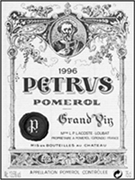
Owner: SC Château Pétrus
Address: 33500 Pomerol
Mailing address: c/o SA Ets Jean-Pierre Moueix, BP 129, 54, quai du Priourat, 33502 Libourne
Telephone: 05 57 51 78 96; Telefax: 05 57 51 79 79
Visits: By appointment and exclusively for professionals of the wine trade dealing with the firm.
Contact: Frédéric Lospied
VINEYARDS
Surface area: 28.2 acres
Grape varietals: 95% Merlot, 5% Cabernet Franc
Average age of vines: 35 years
Density of plantation: 6,500 vines per hectare
Average yields: 36 hectoliters per hectare
Elevage: Twenty to twenty-four day fermentation and maceration in temperature-controlled concrete tanks. Twenty months aging in 100% new oak barrels. Fining, no filtration.
WINES PRODUCED
Pétrus: 25,000–30,000 bottles
Plateau of maturity: Within 10–30 years of the vintage
GENERAL APPRECIATION
Pétrus benefits from an outstanding situation on the plateau of Pomerol. It is one of the most famous red wines in the world, which explains the stratospheric prices it fetches, especially at auction. While this growth was unrivaled for decades (despite its irregular performance in the 1970s and 1980s), in recent years it has had to face increasing competition from many other Pomerols that have improved significantly. In terms of reputation and speculative value, Pétrus remains the king. But in terms of sheer quality, wines such as Lafleur, L’Evangile, Clos l’Église, Le Pin, and several other estates produce equal, sometimes better wines. However, Pétrus represents more than the best Pomerol can offer; it symbolizes a myth more than a wine.
The most celebrated wine of Pomerol, Pétrus has, during the last four decades, become one of Bordeaux’s most renowned as well as expensive red wines. Situated on a buttonhole of black clay in the middle of Pomerol’s plateau, the tiny 28.4-acre vineyard renders wines that are treated as well and as carefully as any wines produced on earth. After administrator Christian Moueix (his brother Jean-François is the actual owner) makes his selection, most vintages of Pétrus turn out to be 100% pure Merlot.
There have been a tremendous number of legendary Pétrus vintages, which no doubt has propelled prices into the stratosphere. The 2000, 1998, 1990, 1989, 1975, 1971, 1970, 1964, 1961, 1950, 1948, 1947, 1945, 1929, and 1921 are among the most monumental wines I have ever tasted. Yet as Pétrus has become deified by much of the world’s wine press, one must ask, particularly in view of this property’s track record from 1976 on, “Is Pétrus as great today as it once was?” There is no doubt that Pétrus slumped in vintages such as 1988, 1986, 1983, 1981, 1979, 1978, and 1976, but since 1989 Pétrus has been in top form, producing a succession of brilliant wines.
IMPORTANT VINTAGES
ANCIENT VINTAGES
Much of the legendary/mythical status of Pétrus is based on what they did in 1950, 1947, 1945, 1929, and 1921. The 1959 (rated 93 in 12/95) was unctuous, sweet, gloriously fruity, thick, and jammy, with gobs of glycerin, full body, and a viscous, long, heady finish. Fully mature, but revealing considerable intensity and life, this is a wine that will drink well for another 10–15 years. It was the extraordinary 1950 Pétrus (99 points; last tasted 6/98) along with the 1950 Lafleur, first served to me years ago by the late Jean-Pierre Moueix, that made me realize how spectacular this vintage must have been in Pomerol. The wine is still a young, mammothly constituted Pétrus that is less evolved than more recent knockout vintages such as 1961. Massive and rich, with spectacular color saturation and the sweet, unctuous texture Pétrus obtains in ripe years, the 1950 will last for another 20–30 years.
While variable, the 1949 (95 points; last tasted 10/94) has always been a huge, thick, chewy, immense wine without the unctuosity and Port-like quality of the 1950 or 1947. The first time I tasted it a decade ago it seemed to be chunky and one-dimensional but enormously rich. Since then the wine has begun to display the huge, exotic, fleshiness of Pétrus, as well as marvelously pure, plum, black cherry, mocha, and coffee-flavored fruit. It is developing well and remains remarkably youthful for a 45-year-old wine. The 1948 (95 points; last tasted 11/97) is another one of those vintages that was largely ignored by the press. Shrewd consumers would be smart to take a look at well-stored bottles of 1948s that might appear in the marketplace. In the past I have reported on some of the other great 1948s, such as Vieux Château Certan, La Mission Haut-Brion, and Cheval Blanc, but the 1948 Pétrus has fooled me completely in blind tastings. The nose of cedar, leather, herbs, and cassis suggested to me that this was a first-growth Pauillac. The color is still dense, with only a moderate orange hue at the edge. The wine is rich, more austere and lineal than usual, but full-bodied with considerable flavor and a spicy, moderately tannic finish. It has peaked but is clearly capable of lasting another 10–15 years. A word of caution: Some bottles possess excessive (even for this epoch) volatile acidity. The 1947 Pétrus (100 points; last tasted 6/98) is the most decadent wine of the century. While not as Port-like as the 1947 Cheval Blanc, it is a massive, unctuously textured, viscous wine with amazing power, richness, and sweet fruit. The nose explodes from the glass, offering jammy fruit, smoke, and buttery caramel scents. The wine’s viscosity is reminiscent of 10 W-40 motor oil. It is so sweet, thick, and rich, one suspects a spoon could stand upright in it. The wine is loaded with dream-like quantities of fruit as well as high alcohol, but there is no noticeable tannin. While drinkable now, given its amazing fruit extract and high levels of glycerin and alcohol, it is capable of lasting two more decades. While the 1947 Pétrus is a big, juicy, succulent, fruity wine, the 1945 (98+ points; last tasted 10/94) remains a backward, tannic colossus needing another 5–10 years of cellaring. The color reveals more purple hues than the 1947, and the nose offers aromas of black fruits, licorice, truffles, and smoked meat. Massively constituted, with formidably high tannin and extract levels, this sleeping giant may evolve into another perfect example of Pétrus.
The 1929 Pétrus displays a deep ruby/garnet color with some amber/orange at the edge. A huge, thick wine with extraordinary aromas of coffee, mocha, black cherries, herbs, and cedar, this unctuously textured, thick, tannic, massively concentrated wine was remarkably intact. It could have easily been mistaken for a 30–35-year-old wine. When I drank it in September 1995, the 1921 Pétrus (100 points) was, to state it mildly, out of this universe! The opaque color displayed considerable amber at the edge, but the blockbuster nose of black raspberries, freshly brewed coffee, and mocha/toffee-like candy was followed by one of the sweetest, most opulent, thick, juicy wines I have ever tasted. Extraordinarily rich and opulent, with interesting cedar notes to the succulent flavors, this huge, unbelievably concentrated wine could have been mistaken for the 1950 or 1947. In December 1996, I tasted what was believed to be a magnum of the 1900 Pétrus found in a private cellar in St.-Emilion. It was excellent rather than exceptional (I rated it 89), still revealing evidence of sweet cherry and blackberry fruit.
Note: Potential purchasers of Pétrus should be aware of the numerous examples of fraudulent bottles that exist in the marketplace. The most sought after vintages—1990, 1989, 1982, 1970, 1961, and 1947—are the most usual suspects. Provenance of any bottle purchased must be guaranteed. The Moueix family has recognized the problem and began utilizing an engraved bottle in the late 1990s.
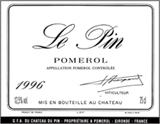
Owner: Jacques Thienpont
Address: 33500 Pomerol
Mailing address: Hof te Cattebeke, Bossenaarstraat 14, 9680 Etikhove, Belgique
Telephone and Telefax: 05 57 51 33 99 (France)
Telephone: 32 55 31 17 59; Telefax: 32 55 31 09 66 (Belgium)
E-mail: wine@thienpont-etikhove.be
Visits: By appointment only
Contact: Jacques or Fiona Thienpont
VINEYARDS
Surface area: 5 acres
Grape varietals: 92% Merlot, 8% Cabernet Franc
Average age of vines: 28 years
Density of plantation: 6,000 vines per hectare
Average yields: 34 hectoliters per hectare
Elevage: Ten to fifteen day fermentation and maceration in temperature-controlled stainless-steel vats. Wines undergo malolactics and are aged 15–18 months in 100% new oak. Fining, no filtration.
WINES PRODUCED
Château Le Pin: 7,000 bottles
No second wine is produced.
Plateau of maturity: Within 8–25 years of the vintage
GENERAL APPRECIATION
The most exotic and flamboyant of Pomerols, Le Pin is the forerunner of the garage wine movement that is more associated with St.-Emilion than Pomerol. It has its followers, and the craving for this particular style of wine combined with the limited availability have contributed to make Le Pin one of the most expensive wines of Bordeaux. Le Pin remains unequaled in terms of seduction, charm, and the sheer pleasure of drinking.
Another Thienpont, this time Jacques, produces this exotic, ripe Pomerol. The original garage wine (500–600 cases are produced from this tiny, postage stamp–size vineyard sandwiched between Vieux Château Certan, Le Croix St.-Georges, and Gombaude Guillot), Le Pin can begin life a bit over the top, with high levels of oak and an excessive exoticism, but it puts on weight and richness with aging. The greatest vintages to date (there have been many) are 2000, 1998, 1990, 1989, and 1982. Other years, such as 1999, 1995, and 1985 are not far off. This tiny vineyard was acquired by the Thienpont family in 1979. By his own admission, Jacques Thienpont is trying to make a wine of great richness and majesty.
Much of the gaudy character of Le Pin is probably explained by the fact that it was one of the first Bordeaux estates to actually conduct the malolactic fermentation of the wine in new oak casks, a technique widely utilized today in neighboring St.-Emilion. This is a labor-intensive procedure and can only be done by estates that have relatively small productions, where the wine can be monitored constantly. However, I believe it is this technique that gives Le Pin its huge, smoky, and exotically scented bouquet. Whatever the secret, no doubt the iron-enriched, gravelly soil on this part of the Pomerol plateau has helped to create a cult following for the microscopic quantities of Le Pin.
Le Pin is still criticized, largely on the grounds that the wine may not fare well with extended cellaring. This may have been a legitimate concern 10 years ago, but none of the early vintages of Le Pin (the first vintage was 1979) have gone off the deep end. In fact, the wine has tended to firm up in the bottle and put on weight. It has even shown greater delineation and richness after 10–15 years than it did when young. Hence, the doom and gloom kindergarten critics who tend to evaluate the price of the wine more than the wine itself have been wrong. The early vintages, which are now about 20 years of age, have held up magnificently. Thus it seems to me that Le Pin is a wine that certainly has the potential to last, in the great years, 25–30+ years.
IMPORTANT VINTAGES
2001 |
Yields were 32 hectoliters per hectare in 2001. Le Pin is the leading candidate for the sexiest, kinkiest, most exotic wine of the vintage. Aromas and flavors of overripe black fruits intermixed with coconut, vanilla, toast, and espresso beans nearly overwhelm the taster. In the mouth, it is fleshy and succulent, with low acidity, ripe tannin, and a pure, sensual personality. Anticipated maturity: 2005–2020. Last tasted, 1/03. |
2000 |
An explosive, virtually perfect example of Le Pin, the dense purple–colored 2000 boasts luxurious levels of extract and richness. This intense, unctuously textured Pomerol bursting with black fruits is thick enough to drink with a spoon. It reveals abundant tannin and definition for such a young Le Pin, typical of many of the blockbuster, but backward and tannic 2000 Pomerols. It is a great wine for the multimillionaires who are able to latch on to a few bottles. Anticipated maturity: 2005–2025. Last tasted, 1/03. |
This is an example of a wine that has gained considerable weight since I first tasted it. Exotic and sexy, with a cunning display of superripe mocha and toast-infused, jammy black cherry fruit, low acidity, and a savory personality, it appears ready to drink, but will undoubtedly take on more delineation and structure as it ages in the bottle. A luxuriously rich, decadent, 100% Merlot, it will be at its finest between 2004–2015. Last tasted, 3/02. |
|
1998 |
A beautifully made, dark ruby/garnet/plum–colored wine, the full-bodied 1998 Le Pin offers an exotic bouquet of coconut, kirsch, and jammy blackberries, all flamboyantly dosed with smoky new oak. It is dense, rich, and plush, with a good tannic framework. At one time, Le Pin was the most exotic wine from Bordeaux’s right bank, but there is now considerable competition from all the new St.-Emilion upstarts. While this remains an outstanding, often compelling Pomerol, many far less expensive, equally prodigious alternatives have emerged. Anticipated maturity: now–2018. Last tasted, 9/02. |
1997 |
While not the strongest effort from this small estate, Le Pin’s 1997 reveals an excessive amount of oak for the concentration of fruit. However, even richer vintages have tended to reveal abundant oak early in life, only to have it absorbed as the wine ages. The 1997 possesses sweet currant and cherry fruit, abundant toasty oak, and a seductive style, but the oak is elevated. The wine will probably not last long enough for the wood to become fully integrated. Or am I wrong about that? Anticipated maturity: now–2008. Last tasted, 3/02. |
1996 |
Like many 1996 Pomerols, there is a certain austerity to the tannins, and the wines are not as generous and voluminous as they would be from a great right bank–vintage like 1998 or 2000. Nevertheless, this is a top-notch example, more structured than usual, but it still has the exotic notes of melted chocolate, roasted espresso, a hint of coconut, and a plethora of jammy black fruits. Relatively supple, even for the vintage, this flamboyant, medium-bodied wine shows superb ripeness, purity, and overall balance with a bit of dry tannin in the finish. Anticipated maturity: 2004–2020. Last tasted, 5/02. |
1995 |
Some of the hard tannins this wine possessed early in life have sloughed off to reveal a wine that has a stunning nose of roasted herbs, caramel, smoke, and barbecue notes along with fruitcake, blackberry and black cherry jam, and a bit of white chocolate entering the smorgasbord of scents. Full-bodied with low acidity but moderately high tannin, it is still a tightly knit, very concentrated wine that is surprisingly structured and backward for Le Pin. It is also a bit more massive than most vintages. Anticipated maturity: 2008–2025. Last tasted, 5/02. |
1994 |
A beautiful 1994, and certainly one of the best wines of the vintage, this medium-bodied Le Pin shows notes of sweet oak intermixed with espresso bean, vanilla, black cherry, licorice, and white chocolate. The wine is medium-bodied and has moderately high tannin, but a luscious, sweet, succulent attack before the tannins begin to kick in. It is hard to peg the actual plateau of maturity for this wine, which seems evolved and complex aromatically but then still has plenty of tannin to shed. Anticipated maturity: 2004–2016. Last tasted, 5/02. |
1990 |
For my taste one of the two finest Le Pins made to date, the 1990 is just starting to hit its adolescent stage and develop secondary nuances. Still a very deep ruby/purple with just a bit of pink at the rim, its explosive aromatics consist of Asian spice, kirsch, fig, blackberry, cherry, and smoky, toasty oak. In the mouth there are layers of concentration, glorious ripeness, copious glycerin, and a seamlessness that has to be tasted to be believed. This a voluptuously textured, full-bodied, remarkable wine that should still have a tremendous upside to it. Anticipated maturity: now–2022. Last tasted, 12/01. |
A slightly firmer, more structured wine than the 1990, with similarly low-acid but more noticeable tannin, the color remains a very healthy saturated ruby/purple. The nose needs more coaxing and offers up notes of coconut, roasted herbs and jus de viande, along with plenty of black currant and sweet cherry fruit with nicely integrated toasty oak. The wine has similarly high levels of glycerin to the 1990, but less accessibility and more structure and possibly power. This is a remarkable wine, and certainly one of the great vintages for Le Pin. Anticipated maturity: 2005–2022. Last tasted, 12/01. |
|
1988 |
This wine has developed nicely in the bottle. The color is a deep ruby with purple nuances. The aggressive oakiness has melted away to reveal plenty of toast and sweet, rich, black cherries, black currants, and a touch of prunes. Chocolaty and rich, this medium-to full-bodied, super-concentrated Le Pin possesses more structure and tannin than is noticeable in many vintages. It is still a beautifully plump, hedonistic wine. Anticipated maturity: now–2010. Last tasted, 11/97. |
1986 |
One of the more structured examples of Le Pin and still surprisingly youthful for a wine that critics say needs to be drunk in its first 5–10 years, this dark garnet–colored wine has notes of licorice, loamy soil scents, sweet black cherries, and currants along with some truffle and vanilla. The wine is medium bodied with a certain firmness and delineation, and less of the charm, glycerin, and opulence that the ripe, more generous vintages provide. The finish is long and almost Médoc-like. Anticipated maturity: now–2015. Last tasted, 12/01. |
1985 |
A sexy tart of a wine, this open-knit, expensive, fleshy wine offers up sumptuous notes of smoked herbs, melted caramel, espresso, jammy black currant and cherry fruit, and plenty of licorice. Very sweet, round, and luscious in the mouth with an unctuous texture, no obvious tannins, and a silky-textured, lush finish, this fully mature Le Pin should continue to drink well for 5–10 more years. Anticipated maturity: now–2012. Last tasted, 12/01. |
1983 |
This wine seems to have been better several years ago. It still is a great bottle of wine, but may just be beginning to slip in terms of intensity and complexity. Dark garnet with some orange/amber at the rim, its sweet ripe nose of Provençal herbs intermixed with licorice, tree bark, truffle, and blackberry and cherry jam is followed by a medium-bodied, very lush, flavorful wine that is kinky, exotic, and just sumptuous. It needs to be drunk up, however. Anticipated maturity: now–2009. Last tasted, 12/01. |
1982 |
A wine that has gained stature and weight in the bottle, the 1982 now seems to have hit its magical stride, where hopefully it will stay for another 5+ years. The color is a dense ruby/garnet with some amber at the edge. The soaring aromatics consist of melted caramel, espresso, Asian spice, and sweet, almost overripe prune, black currant, and fig. In the mouth it is layered, lavishly concentrated, very full-bodied, and sweet (from ripe fruit, not sugar). The wine seems very low in acidity, but the tannins remain, although they are very ripe and integrated. This is a decadent, extravagantly rich style of wine that is nearly over the top. Anticipated maturity: now–2012. Last tasted, 11/02. |
ANCIENT VINTAGES
I have not tasted the 1981, 1980, or 1979, (the 1979 being the debut vintage for Le Pin) since the last edition of this book, but I suspect they are sound wines if well stored.
Note: Le Pin is another luxury wine that has become the darling of criminals specializing in the production of phony bottles. In particular, the 1982 is a favorite of counterfeiters.
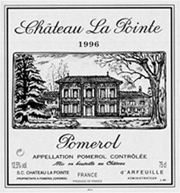
Owner: d’Arfeuille family
Address: 33500 Pomerol
Telephone: 05 57 51 02 11; Telefax: 05 57 51 42 33
E-mail: chateau.lapointe@wanadoo.fr
Website: www.chateaulapointe.com
Visits: By appointment only
Contact: Stéphane d’Arfeuille
VINEYARDS
Surface area: 54.3 acres
Grape varietals: 75% Merlot, 25% Cabernet Franc
Average age of vines: 35 years
Density of plantation: 5,500 vines per hectare
Average yields: 47 hectoliters per hectare
Elevage: Four to five week fermentation and maceration in temperature-controlled concrete vats. Fifteen to eighteen months aging in barrels with 35% new oak. Fining and filtration.
WINES PRODUCED
Château La Pointe: 130,000 bottles
La Pointe Riffat: 20,000 bottles
Plateau of maturity: Within 3–10 years of the vintage
GENERAL APPRECIATION
This is a solidly made Pomerol that has improved in quality since the late 1990s.
La Pointe has been an irregular performer. The wines can be round, fruity, simple, and generous, as in 1970, but far too frequently they are boringly light and unsubstantial. Older vintages, such as 1979, 1978, 1976, and 1975, were all uncommonly deficient in the rich, chewy, supple, zesty fruit that one finds so typical of a good Pomerol. The large production insures that the wine is widely promoted. The owners have increased the percentage of Merlot significantly since the early 1970s. All things considered, this once mediocre Pomerol has shown improvement during recent vintages.
IMPORTANT VINTAGES
2001 |
A noteworthy effort from La Pointe, the 2001 exhibits a deep ruby/purple color, sweet fruit, medium body, fine purity, and sweet tannin. Very good, it will drink well young. Anticipated maturity: 2005–2014. Last tasted, 1/03. |
2000 |
This is an elegant, soft, medium-bodied, straightforward wine with abundant black cherry fruit intermixed with earth, oak, and spice. Although slightly compressed, it is well made, medium-bodied and clean. Drink it over the next decade. Last tasted, 1/03. |
The 1999 La Pointe’s deep ruby/purple color is accompanied by an excellent, multilayered personality, a chewy texture, abundant quantities of plum, cherry, cola, and mocha flavors, excellent concentration, sweet tannin, and low acidity. Anticipated maturity: now–2012. Last tasted, 3/02. |
|
1998 |
Soft, fruity, and diffuse, this elegant, lightweight effort is pleasant, but lacks substance as well as follow-through on the palate. Drink it over the next 1–2 years. Last tasted, 3/02. |
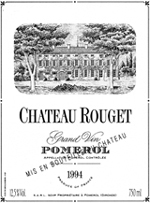
Owner: Labruyère family
Address: 33500 Pomerol
Telephone: 05 57 51 05 85; Telefax: 05 57 51 05 85
Visits: By appointment only
Contact: Mr. Ribeiro
VINEYARDS
Surface area: 43.4 acres
Grape varietals: 85% Merlot, 15% Cabernet Franc
Average age of vines: 28 years
Density of plantation: 6,000 vines per hectare
Average yields: 35 hectoliters per hectare
Elevage: Fermentations occur in temperature-controlled stainless-steel vats. Wines are aged in oak barrels and renewed by a third at each vintage for approximately 15 months. (Starting in 1977, malolactics occur in new oak barrels.)
WINES PRODUCED
Château Rouget: 29,000 bottles
Vieux Château des Templiers: 29,000 bottles
Plateau of maturity: Within 5–15 years of the vintage
GENERAL APPRECIATION
While Rouget enjoyed a fine reputation in the 1940s, it was a less than stellar performer until the mid 1980s. Since its acquisition by the Labruyère family, its wines have improved considerably and, though they retain their characteristic rusticity, they now show more concentration, stuffing, and suppleness than in the past. Recent vintages have been very good.
Historically, Rouget is one of Pomerol’s most illustrious estates. In one of the early editions of Cocks et Féret’s Bordeaux et ses Vins, the vineyard was ranked fourth among all the Pomerols. At present, their reputation has been surpassed by numerous properties, but there is no question that Rouget can be a rich and interesting wine. For example, both the 1947 and 1945 vintages were dazzling wines that were both still drinking superbly in the late 1980s. Until recently François-Jean Brochet ran this old yet beautiful estate that sits in the northernmost part of the Pomerol appellation on very sandy soil, with a lovely view of the Barbanne River visible through the trees. The wine was traditionally made by Brochet, who also maintained an immense stock of old vintages. Brochet’s sale of the property to the Lambruyère family has resulted in much-needed improvements.
The style of Rouget is one that makes no concessions to consumers who want to drink their wine young. It is a darkly colored, rich, full-bodied, often very tannic wine that usually is in need of a minimum of 8–10 years of cellaring. It is sometimes too coarse and rustic, but almost always a delicious, rich, ripe, spicy wine. Recent vintages of the late 1990s have tasted more supple. The vintages of the late 1960s, 1970s, 1980s, and early 1990s are of little merit. After two decades of mediocrity, this property rebounded beautifully over the last few vintages and is now producing impressive wines. The price is beginning to escalate accordingly as more Bordeaux wine traders and consumers catch on.
IMPORTANT VINTAGES
2001 |
The noteworthy 2001 is, along with the 2000, one of the biggest, richest Rougets I have tasted. Its deep ruby/purple color is accompanied by a sweet perfume of balsam wood, plums, and black cherry liqueur presented in a nicely extracted, well-balanced style. Medium to full-bodied, with low acidity and abundant thickness as well as flavor, it should drink well young and last for 10–13 years. Last tasted, 1/03. |
2000 |
The most complete, complex, and powerful Rouget since 1964 and 1961, the dense plum/ruby–colored 2000 boasts a knockout nose of smoked herbs, jammy fruit with a liqueur-like intensity, terrific purity, and admirable sweetness on the attack and mid-palate. It has become richer and more textured over the last year, but unlike many 2000 Pomerols, it does not possess the hard tannin that recalls the 1975 vintage. Anticipated maturity: 2006–2020. Last tasted, 1/03. |
1999 |
An excellent, textbook Pomerol with notes of roasted coffee, mocha, cola, and black cherry liqueur, this lush, sexy, tasty, medium-bodied 1999 is low in acidity with plenty of ripe tannin. It is ideal for drinking over the next decade. Last tasted, 3/02. |
1998 |
Dark ruby/purple–colored, with a ripe nose of chocolate, black fruits, brandy-macerated cherries, figs, and prunes, this medium-to full-bodied, plush Rouget reveals a chewy, concentrated texture as well as a ripe, fat finish. With a bit more definition and complexity, it would have merited an outstanding score. Anticipated maturity: now–2015. Last tasted, 3/02. |
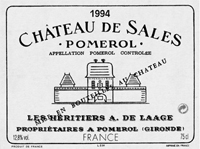
Owner: GFA du Château de Sales
Address: 33500 Libourne
Telephone: 05 57 51 04 92; Telefax: 05 57 25 23 91
Visits: By appointment only
Contact: Bruno de Lambert
VINEYARDS
Surface area: 117.3 acres
Grape varietals: 70% Merlot, 15% Cabernet Sauvignon, 15% Cabernet Franc
Average age of vines: 30 years
Density of plantation: 5,600 vines per hectare
Average yields: 49 hectoliters per hectare
Elevage: Eighteen to twenty-four day fermentation and maceration in temperature-controlled concrete vats (max 30°C). After completion of malolactics, 18 months aging, wines in barrels (renewed by a third at each vintage) for half the time and in vats for the other (rotation at the time of racking off, every three months). Fining, light filtration upon bottling.
WINES PRODUCED
Château de Sales: 150,000 bottles
Château Chantalouette: 60,000 bottles
Plateau of maturity: Within 3–10 years of the vintage
GENERAL APPRECIATION
After a difficult period in the 1980s and until the mid 1990s, de Sales is back on track, which is good news for consumers. The estate offers one of the most pleasant and most reasonably priced Pomerols.
De Sales is the largest vineyard in Pomerol and boasts the appellation’s only grand château. The property is located in the northwestern corner of Pomerol with a vineyard planted primarily on sandy soil intermixed with gravel. The owners and managers are the de Lambert family. The wines are increasingly among the most enjoyable of the Pomerols. They are prized for their sheer, supple, glossy, round, generous, ripe fruitiness, and lush, silky personalities. De Sales has had an irregular track record in the 1980s and 1990s but the recent vintages have been particularly strong. It is never a powerful, aggressive, oaky, or big wine, and it always offers immediate drinkability. In spite of a precocious style, it has a cunning ability to age well for 10–12 years.
While consistently good, de Sales will never be a great Pomerol, but its price remains modest, making it a good value.
IMPORTANT VINTAGES
2001 |
The 2001 is a savory, ripe, medium-bodied offering with plenty of flesh and up-front charm. It possesses a saturated deep ruby color, copious quantities of black cherry fruit, medium body, and a soft, succulent finish. Consume this hedonistic, totally charming, mid-weight Pomerol during its first 8–10 years of life. Last tasted, 1/03. |
2000 |
The finest de Sales since the 1982 (probably better), the deep ruby/purple–colored 2000 boasts sweet aromas of soil, kirsch, raspberries, and currants. Layered and opulent, with sweet tannin and medium to full body, it is atypically large-scaled for a wine from this estate. Bravo! Anticipated maturity: 2005–2015. Last tasted, 1/03. |
1999 |
Readers seeking a Burgundian-style wine with gobs of black cherry fruit, expansive, savory texture, sexy aromatics, and loads of glycerin and fruit should check out this medium-bodied, lush Pomerol. It should be drunk over the next decade. Last tasted, 3/02. |
Together with the 2000, this is one of the finest de Sales produced since the early 1980s. The medium ruby/garnet–colored 1998 is forward and soft, revealing notions of white chocolate, mocha, and kirsch. Made in a seductive, luscious style, it possesses sweet tannin, a supple mid-palate as well as finish, and excellent concentration. Purchasers will have no need to defer their gratification. Anticipated maturity: now–2010. Last tasted, 3/02. |
ANCIENT VINTAGES
This is a wine that normally needs to be drunk in the first 10–12 years of life. Older vintages are generally of little importance. Those that may still be drinking well if stored properly include the 1995 (87 points; last tasted 3/99), 1990 (89 points; last tasted 11/99), and 1982 (87 points; last tasted 11/02).
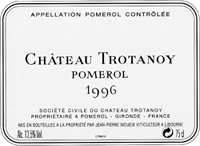
Owner: SC Château Trotanoy
Address: 33500 Pomerol
Mailing address: c/o SA Ets Jean-Pierre Moueix, BP 129, 54, quai du Priourat, 33502 Libourne
Telephone: 05 57 51 78 96; Telefax: 05 57 51 79 79
Visits: By appointment and exclusively for professionals of the wine trade dealing with the firm.
Contact: Frédéric Lospied
VINEYARDS
Surface area: 17.8 acres
Grape varietals: 90% Merlot, 10% Cabernet Franc
Average age of vines: 35 years
Density of plantation: 6,200 vines per hectare
Average yields: 39 hectoliters per hectare
Elevage: Twenty day fermentation and maceration in temperature-controlled concrete tanks. Twenty months aging in barrels with 40% new oak. Fining, no filtration.
WINES PRODUCED
Château Trotanoy: 30,000 bottles
No second wine is produced.
Plateau of maturity: Within 7–25 years of the vintage
GENERAL APPRECIATION
Trotanoy was excellent before the 1970s, then went through a difficult period in the 1980s and the beginning of the 1990s, producing much lighter wines than in the past. However, it rebounded beautifully in 1995 and since then has offered an uninterrupted string of fine vintages. The vineyard benefits from an exceptional situation, and when Trotanoy hits the bull’s-eye, it can easily rival its stablemate Pétrus. In terms of quality, in the late 1990s this wine is on par with such stars of the appellation as L’Eglise-Clinet, L’Evangile, and La Conseillante.
Trotanoy has historically been one of the great wines of Pomerol and all of Bordeaux. Since 1976, Trotanoy has been the quality equivalent of a second growth. In vintages prior to 1976, Trotanoy was often as profound as a first growth.
Since 1953, Trotanoy has been owned by the firm of Jean-Pierre Moueix. The château is unmarked (it is the residence of Jean-Jacques Moueix). The vineyards of this modest estate, which lie a kilometer to the west of Pétrus between the church of Pomerol and the village of Catusseau, are situated on soil of clay and gravel. The wine is vinified and handled in exactly the same way as Pétrus, except only 40% new oak barrels are used each year.
Until the late 1970s, Trotanoy was an opulently rich, intense, full-bodied wine that usually needed a full decade of cellaring to reach its zenith. In some vintages the power, intensity, and concentration came remarkably close to matching that of Pétrus. It had an enviable track record of producing good, sometimes brilliant, wines in poor Bordeaux vintages. The 1974, 1972, and 1967 were three examples of vintages where Trotanoy was among the best two or three wines of the entire Bordeaux region.
In the late 1970s the style became lighter, although Trotanoy appeared to return to full form with the extraordinarily opulent, rich, decadent 1982. Until 1995 there was a succession of good, rather than thrilling, wines. There is no question that there has been some major replanting of the micro-size vineyard of Trotanoy and that the production from these younger vines was blended in. Whatever the case might be, Trotanoy no longer seems to be one of the top three or four wines of Pomerol, and it was surpassed in the 1980s (with the exception of the 1982 vintage) by such châteaux as Clinet, L’Eglise-Clinet, Vieux Château Certan, Le Pin, Lafleur, La Fleur de Gay, L’Evangile, La Conseillante, and even Le Bon Pasteur in specific vintages. Given the competitiveness and talent of Christian Moueix and his staff, this situation appears to be changing. Recent vintages have all been strong, including a beautiful 1995 and sensational 1998, as well as 2000.
Trotanoy is an expensive wine because it is highly regarded by connoisseurs the world over. Yet it rarely sells for more than half the price of Pétrus—a fact worth remembering since it does (in certain vintages) have more than just a casual resemblance to the great Pétrus itself.
IMPORTANT VINTAGES
2001 |
With considerable harmony, elegance, and medium weight, the 2001 Trotanoy might evolve along the lines of the 1979 or the incredible 1967. It possesses a deep plum/ruby/purple color as well as a sweet nose of earth, truffles, black cherries, and currants, medium-bodied flavors, and impeccable purity. Tannin is present, but is not overdone. This wine has put on considerable weight and is not far off the mark of the 2000. Anticipated maturity: 2006–2016. Last tasted, 1/03. |
2000 |
The 2000 Trotanoy may be nearly as profound as the prodigious 1998. A dense murky ruby/purple color is followed by sensational aromas of black fruits, cherries, figs, plums, truffles, and earth. Extremely full-bodied and deep, with huge flavor extraction, sweet but noticeable tannin, and a 50-second finish, this compelling Trotanoy signals a return to form for this great terroir, which, during the 1950s, 1960s, and early 1970s, often rivaled Pétrus. Anticipated maturity: 2009–2030. Last tasted, 1/03. |
Delicious, elegant aromas and flavors of earth, mocha, cherries, and tobacco characterize this middle weight, dark ruby–colored 1999. It offers low acidity, sweet fruit, and an appealing combination of accessibility and balanced elegance. Drink it over the next 10–12 years. Last tasted, 3/02. |
|
1998 |
The finest Trotanoy since the 1961, this structured, formidably endowed, deep ruby/purple–colored, full-bodied, superrich wine exhibits notes of toffee, truffles, and abundant blackberry, cherry, and currant fruit. It cuts a large swath across the palate and possesses copious but sweet tannin as well as a chewy, muscular mid-palate and finish. This is a compelling effort from one of the great vineyards of Pomerol. Anticipated maturity: 2006–2035. Last tasted, 11/02. |
1997 |
The 1997 is an atypically structured, rich, powerful wine for the vintage, with hard tannin in the finish. It is ripe and medium bodied, with surprising depth as well as copious quantities of plum, cherry, currant, truffle, herb, and earth aromas and flavors. Could this be a modern-day version of the underrated 1967? It should age for 12+ years. Last tasted, 3/02. |
1996 |
Dark ruby with surprising pink at the rim, the 1996 Trotanoy seems very tightly knit, with dusty tannins and hints of sweet-and-sour cherry fruit, finishing to a somewhat liquid minerality and spicy note. The wine has plenty of muscle, very high levels of tannin, but a somewhat unimpressive mid-palate. Whether it fleshes out remains to be seen, but I am somewhat doubtful. This wine seems to be increasingly less impressive. Anticipated maturity: 2008–2016. Last tasted, 2/02. |
1995 |
Certainly the best Trotanoy between 1998 and 1982, the 1995 has a deep saturated ruby color that is dark to the rim. Relatively shut down when tasted in 2002 on several occasions, the wine, with coaxing, does offer some notes of earth, raspberry, black cherries, and a hint of licorice. Medium to full-bodied, powerful, and backward, it is an impressively constituted Trotanoy that is relatively large-scaled, but the huge level of tannin also means it might be a modern-day version of the 1970. Time will tell. Anticipated maturity: 2010–2025. Last tasted, 2/02. |
1994 |
Beginning to show some evolution, the dark plum/garnet–colored 1994 Trotanoy has a certain herbaceousness and an interesting beef bouillon smell intermixed with some sweet cherries and earth. On the palate, it is a medium-bodied wine with sweet fruit, good brightness, but some relatively hard and slightly astringent tannins in the finish. That latter characteristic may become worrisome if they do not melt away. Anticipated maturity: 2004–2016. Last tasted, 2/02. |
1990 |
Very evolved and far more mature than its bigger sibling (the 1990 Pétrus), this dark plum–colored wine is already showing some amber at the edge. It is forward and sweet, with sweet-and-sour cherry fruit intermixed with a hint of herbs, licorice, fig, and earth. The wine is medium bodied with sweet fruit, low acidity, and a very nicely layered finish. All things considered, it is a very elegant, understated Trotanoy that is outstanding, but well behind the best Pomerols of the vintage. Anticipated maturity: now–2012. Last tasted, 2/02. |
1989 |
A very delicate, elegant wine that has reached full maturity, again the notes of baked herbs, even tapenade, are intermixed with sweet-and-sour cherries. Medium bodied, soft, and easy to drink, this rather lightweight Trotanoy needs to be consumed over the next decade. Last tasted, 2/02. |
1988 |
An unexciting, somewhat indifferent style of wine, the medium garnet color offers up a nose of mushrooms, earth, and licorice, with some ripe cherry fruit. In the mouth there is not much concentration, and some dry astringent tannins are in the finish. It is not going to get any better, but it is certainly capable of lasting for up to a decade. Anticipated maturity: now–2010. Last tasted, 2/02. |
Another rather hollow, commercial style of wine that shows vegetal aromas along with herbal tea, licorice, and some faded candied cherry notes. The color is an evolved medium ruby with plenty of amber. The wine’s finish is short, medium-bodied, with evidence of dilution. Anticipated maturity: Drink it up. Last tasted, 2/02. |
|
1985 |
Made during a disappointing era for Trotanoy when the wines lacked concentration and often tasted vegetal, this wine is fully mature with notes of tapenade intermixed with herbes de Provence, cherry jam, and even a hint of strawberry and red currant. Some acidity and tannin continue to assert themselves in the wine’s finish, suggesting this wine has seen better days and needs to be drunk up. Anticipated maturity: now. Last tasted, 2/02. |
1982 |
Fully mature, gorgeously fragrant, with a knockout nose of sweet herbs intermixed with toast, jammy strawberry, and black cherry fruit as well as mocha and cedar, this dense garnet–colored wine is medium to full-bodied, expansive, and lush, with low acidity and a long, concentrated finish with considerable glycerin. It is not going to improve, but certainly this wine will hold for at least another 10–15 years. Last tasted, 12/02. |
ANCIENT VINTAGES
Trotanoy’s 1975 (94 points; last tasted 11/02) is stunning and was drunk on three different occasions in 2002. The 1971 is another great wine (93 points; last tasted 7/97), but it has been fully mature for nearly 20 years, so I would not push its evolution any further. A wine that seems to have fallen in stature is the 1970, rated as high as 96+ in 8/96, but recent bottles, both from magnums (rated 92 and 94), seemed alarmingly high in tannin while youthful. The color is still a dark ruby/purple with little lightening at the edge. The wine is sweet on the attack with plenty of berry fruit, earth, meat, and leather, but the tannins seem increasingly astringent. I have always felt this wine could last through 2030 and don’t doubt that it will, but I wonder about its overall balance and the dry astringency of the tannins. Among other ancient vintages, the 1967 (which hasn’t been tasted in many a year) was a stunning wine and one of the top two or three wines of the vintage. The 1964 was also great and probably still delicious, but I have not tasted it in over a decade. The 1961 could be immortal. I rated it 100 when last tasted 1/01 from a magnum. The wine was opulent, viscous, rich—just an extraordinary glass of wine, and, for my tastes, the finest Trotanoy I have ever had. From pristine bottles this wine is prodigious and can easily last another 20 years.
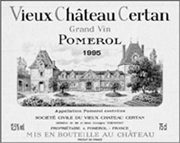
Owner: Thienpont family
Address: 33500 Pomerol
Telephone: 05 57 51 17 33; Telefax: 05 57 25 35 08
E-mail: info@vieuxchateaucertan.com
Website: www.vieuxchateaucertan.com
Visits: By appointment only Monday to Friday, 10 A.M.–noon and 2–6 P.M.
Contact: Alexandre Thienpont
Surface area: 34.6 acres
Grape varietals: 60% Merlot, 30% Cabernet Franc, 10% Cabernet Sauvignon
Average age of vines: 35 years
Density of plantation: 5,800 vines per hectare
Average yields: 40 hectoliters per hectare
Elevage: Thirty day fermentation and maceration in wooden vats. The Merlots undergo malolactics in barrel. Eighteen to twenty-two months aging in new oak. Fining, no filtration.
WINES PRODUCED
Vieux Château Certan: 40,000 bottles
La Gravette de Certan: 20,000 bottles
Plateau of maturity: Within 5–25 years of the vintage
GENERAL APPRECIATION
Vieux Château Certan was once considered the most elegant and finesse-styled Pomerol, but it was surpassed by Pétrus in the post–World War II period. However, the vineyard benefits from an exceptional situation and the potential of its terroir has been fully exploited over recent years. While the wines have retained their Médoc-like elegance and aromas, they possess more stuffing and structure.
One of the most famous names in Pomerol is the pride and joy of the Thienpont family, the owners of Vieux Château Certan. In the 19th century, as well as the early part of the 20th century, Vieux Château Certan was considered to have produced the finest wine of Pomerol. However, following World War II, this distinction was surpassed by Pétrus. The two wines could not be more different. Vieux Château Certan bases its style and complexity on a high percentage of Cabernet Franc, whereas Pétrus is nearly 100% Merlot. The vineyard, located in the heart of the plateau, is surrounded by much of the reigning aristocracy of the appellation—Lafleur, Certan de May, La Conseillante, L’Evangile, Petit Village, and Pétrus—and has a gravelly soil with a subsoil of iron-enriched clay. The wine that emerges from the vineyard never has the strength of a Pétrus, or other Merlot-dominated wines of the plateau, but it often has a perfume and elegance that recalls a top wine from the Médoc.
A visit to the chai of Vieux Château Certan reveals a healthy respect for tradition. For most of the post–World War II era, Vieux Château Certan was made by Léon Thienpont, but since his death in 1985 the property has been managed by his son, Alexandre, who apprenticed as the régisseur at the St.-Emilion château of La Gaffelière. When the young, shy Thienpont took over the estate, old-timers scoffed at his lack of experience, but he asserted himself immediately, introducing crop-thinning techniques and malolactic in barrel for the Merlot.
Because of its historic reputation for excellence, Vieux Château Certan is an expensive wine.
ANCIENT VINTAGES
In the 1970s Vieux Château Certan’s performance was shaky, with only the 1975 (90 points; last tasted 12/88) being a wine of considerable merit. In the 1960s everyone has long acknowledged the brilliance of the 1964 (90 points; last tasted 6/00). The 1961 has never been an exciting wine. Among the other vintages, Vieux Château Certan’s fame could not have been greater than during the period between 1945 and 1950. The 1952 Vieux Château Certan (94 points; last tasted 10/94) is in extraordinary condition. The wine, a sleeper, was sweet and cedary, with a huge, almost hickory, roasted, smoky nose that was reminiscent of a top Graves. Full-bodied, with glorious concentration and richness, this wine still possesses plenty of tannin and youthfulness. It will easily keep for another 10–20 years. The 1950 (99 points; last tasted 12/02) is a remarkably rich, still youthful wine from this fabulous vintage in Pomerol. The color remains an amazing garnet/purple, and the nose offers sensationally ripe, chocolaty, cassis aromas intertwined with herbs, licorice, Asian spices, and coffee. Extremely full-bodied with Port-like viscosity similar to the 1947, this blockbuster wine must be one of the least-known profound wines of the century.
The 1948 Vieux Château Certan (98 points; last tasted 7/02) is another profoundly great wine from the forgotten vintage of the 1940s. I have tasted this wine four times in the last year, and it was exceptional in each tasting. The opaque dark purple/garnet color is followed by a huge, exotic nose of caramel, sweet cassis, soy sauce, walnuts, and coffee. Thick, chewy, fabulously concentrated flavors with low acidity and high tannin coat the palate. There is amazing glycerin and an elevated alcohol level to this super-concentrated wine. Although fully mature, it exhibits no signs of decline and will easily last for 15–20 more years. Remarkable! A dazzling wine, which I have tasted a number of times over the years, the 1947 Vieux Château Certan (99 points; last tasted 1/01) is typical of so many 1947 Pomerols. Its thick, viscous, Port-like style and texture are the hallmarks of this vintage. More advanced than the 1948, it reveals a smoky, meaty, truffle, and black currant–scented nose, as well as massive, chewy flavors loaded with glycerin, extract, and alcohol. It exhibits more amber at the edge than the 1948, but, wow, what a mouthful of wine! Like many 1947 Pomerols, its unctuosity and thickness make me wonder if a spoon would stand up in the glass without any support. Drink it over the next 10–12 years. Tasted twice and rated highly each time, the 1945 (98 points; last tasted 1/01) is an exceptional winemaking effort in what can be a frightfully tannic vintage. It exhibits a dark, murky, plum color, with little garnet at the edge. It also possesses a huge nose of smoked meats, black raspberries, plums, licorice, and tar. Dense, chewy, and powerful, with gobs of tannin and amazing fruit extraction, this full-throttle wine must be at its plateau of maturity, yet I see no reason it cannot last for two more decades.
Dark garnet, with noticeable rust/amber at the edge, the spicy, peppery, herbaceous, sweet, caramel- and black fruit–scented 1928 Vieux Château Certan (96 points; last tasted 10/94) possesses huge, chewy flavors, copious quantities of tannin, full body, and a rustic, astringent finish. Still in superb condition, it is capable of lasting 10–20 more years.
OTHER POMEROL ESTATES
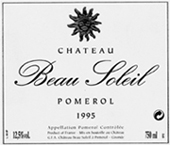
Owner: Anne-Marie Audy-Arcaute
Address: 33500 Pomerol
Mailing address: c/o Château Jonqueyres, 33750 Saint-Germain du Puch
Telephone: 05 57 34 51 66; Telefax: 05 56 30 11 45
E-mail: delphine.mousset-derouet@gamaudy.com
No visits
VINEYARDS
Surface area: 7.4 acres
Grape varietals: 95% Merlot, 5% Cabernet Sauvignon
Average age of vines: 35 years
Density of plantation: 6,600 vines per hectare
Average yields: 48 hectoliters per hectare
Elevage: Two to three week fermentation and maceration in temperature-controlled stainless-steel vats of small capacity. Twenty-four months aging in new oak. No fining, no filtration.
WINES PRODUCED
Château Beau Soleil: 22,000 bottles
No second wine is produced.
Plateau of maturity: Within 5–15 years of the vintage
GENERAL APPRECIATION
Beau Soleil is a soundly made Pomerol. Generally rich and fruity, it is less well-known than its sibling, La Croix du Casse, but it is nearly as good while selling for a lower price.
IMPORTANT VINTAGES
2000 |
Opaque purple–colored with notes of blackberries, mocha, and licorice, this is a strong, powerful effort with moderate tannin, medium to full body, and good sweetness as well as purity. The 2000 Beau Soleil was the last vintage produced by Jean-Michel Arcaute before his tragic, premature death in 2001. Anticipated maturity: 2006–2016. Last tasted, 1/03. |
1999 |
Excellent sweet fruit is nicely complemented by toasty oak, licorice, and ripe black cherry scents. Soft, round, and consumer-friendly, with low-acid and sweet tannin, this appealing wine should be drunk over the next 7–8 years. Last tasted, 3/02. |
This dark ruby–colored offering reveals mocha, caramel, jammy black plums, cherries, and smoke characteristics, a soft, up-front, medium- to full-bodied personality, and an open-knit, creamy texture. Drink this sexy 1998 over the next 10 years. Last tasted, 3/02. |
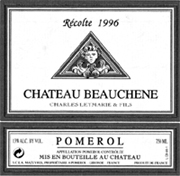
Owner: Leymarie family
Address: 15, impasse du Vélodrome, 33500 Libourne
Mailing address: Charles Leymarie et Fils, 90–92, avenue Foch, 33500 Libourne
Telephone: 05 57 51 07 83; Telefax: 05 57 51 99 94
Visits: By appointment only
Contact: Gregory Leymarie
VINEYARDS
Surface area: 24 acres
Grape varietals: 65% Merlot, 30% Cabernet Franc, 5% Cabernet Sauvignon
Average age of vines: 40 years
Density of plantation: 5,500 vines per hectare
Average yields: 44 hectoliters per hectare
Elevage: Fifteen to thirty day fermentation and maceration in temperature-controlled concrete vats. The grand vin undergoes malolactics in barrel. Eighteen months aging in new oak. Fining and light filtration.
WINES PRODUCED
Château Beauchêne: 12,000 bottles
Clos Mazeyres: 43,000 bottles
Plateau of maturity: Within 3–15 years of the vintage
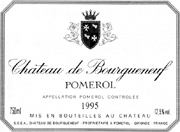
Owner: Meyer family
Address: Vignobles Meyer, 7, chemin de la Cabanne, 33500 Pomerol
Telephone: 05 57 51 16 73; Telefax: 05 57 25 16 89
Visits: By appointment only
Contact: Jean-Michel Meyer
VINEYARDS
Surface area: 12.4 acres
Grape varietals: 70% Merlot, 15% Cabernet Franc, 15% Cabernet Sauvignon
Average age of vines: 40 years
Density of plantation: 6,000 vines per hectare
Average yields: 50 hectoliters per hectare
Elevage: Three to four week fermentation and maceration in temperature-controlled stainless-steel and concrete vats. Twelve to sixteen months aging in barrels with 50% new oak. Fining and filtration.
WINES PRODUCED
Château de Bourgueneuf: 20,000 bottles
Clos Grangeneuve: 5,000 bottles
Plateau of maturity: Within 5–20 years of the vintage (since 1994)
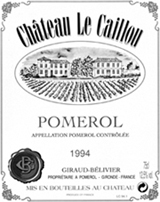
Owner: GFA Giraud-Bélivier
Address: 33500 Pomerol
Mailing address: c/o SARL André Giraud, 33500 Pomerol
Telephone: 05 57 51 06 10; Telefax: 05 57 51 74 95
E-mail: giraud-belivier@wanadoo.fr
Visits: By appointment only weekdays except Wednesdays, 9 A.M.–noon and 2–6 P.M.
Contact: André Giraud
VINEYARDS
Surface area: 17.3 acres
Grape varietals: 75% Merlot, 25% Cabernet Franc
Average age of vines: 25 years
Density of plantation: 5,500 vines per hectare
Average yields: 48 hectoliters per hectare
Elevage: Three to four week fermentation and maceration in concrete tanks. Twelve months aging, by rotation every three months (time of racking), with two-thirds of yield in oak barrels and the rest in concrete vats. Fining, no filtration.
WINES PRODUCED
Château Le Caillou: 39,000 bottles
La Fleur Lacombe: Variable
Plateau of maturity: Within 5–15 years of the vintage
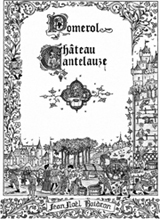
Owner: Jean-Noël Boidron
Address: 6, place Joffre, 33500 Libourne
Telephone: 05 57 51 64 88; Telefax: 05 57 51 56 30
Visits: Monday to Friday, 8–11 A.M. and 2–5 P.M.
Contact: Emmanuel Boidron
VINEYARDS
Surface area: 2.2 acres
Grape varietals: 90% Merlot, 10% Cabernet Franc
Average age of vines: 20 years
Density of plantation: 5,865 vines per hectare
Average yields: 38 hectoliters per hectare
Elevage: Three to four week fermentation and maceration in temperature-controlled stainless-steel vats without addition of yeast. Eighteen months aging in 100% new oak. Fining, no filtration.
WINES PRODUCED
Château Cantelauze: 4,000 bottles
No second wine is produced.
Plateau of maturity: Within 4–12 years of the vintage
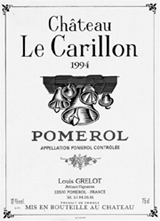
Owner: Louis Grelot
Address: 33500 Pomerol
Telephone: 05 57 84 56 61
Visits: By appointment only
Contact: Louis Grelot
VINEYARDS
Surface area: 2.47 acres
Grape varietals: 100% Merlot
Average age of vines: 8 years
Density of plantation: 5,500 vines per hectare
Average yields: 35 hectoliters per hectare
Elevage: Twenty-one day fermentation in wooden vats. Wines are transferred after malolactics to oak barrels (25% of which are new) for 18 months aging and sometimes more. Fining, no filtration.
Château Le Carillon: 4,700 bottles
No second wine is produced.
Plateau of maturity: Within 3–10 years of the vintage
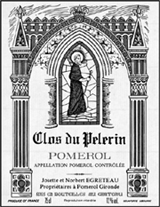
Owner: Norbert and Josette Egreteau
Address: 3, chemin de Sales, 33500 Pomerol
Telephone: 05 57 74 03 66; Telefax: 05 57 25 06 17
Visits: By appointment only
Contact: Norbert and Josette Egreteau
VINEYARDS
Surface area: 8.6 acres
Grape varietals: 80% Merlot, 10% Cabernet Franc, 10% Cabernet Sauvignon
Average age of vines: 25 years
Density of plantation: 6,000 vines per hectare
Average yields: 50 hectoliters per hectare
Elevage: Twelve months aging in vats followed by 12 months in barrels that are renewed by a third every year. Fining, no filtration.
WINES PRODUCED
Clos du Pèlerin: 12,000 bottles
Plateau of maturity: Within 5–12 years of the vintage
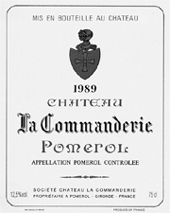
Owner: Marie-Hélène Dé
Address: Catusseau, 33500 Pomerol
Mailing address: 4, chemin de la Commanderie, 33500 Pomerol
Telephone: 05 57 51 79 03; Telefax: 05 57 25 31 91
Visits: By appointment only
Contact: Marie-Hélène Dé or Mr. Lamothe (05 57 51 75 94)
VINEYARDS
Surface area: 14.2 acres
Grape varietals: 80% Merlot, 20% Cabernet Franc
Average age of vines: 50 years
Density of plantation: 6,000 vines per hectare
Average yields: 40–45 hectoliters per hectare
Elevage: Two to three week fermentation and maceration in stainless-steel vats. Eighteen months aging in vats and in barrels, with 33–50% new oak. Light fining and filtration.
WINES PRODUCED
Château La Commanderie: 20,000 bottles
Château Haut-Manoir: 10,000 bottles
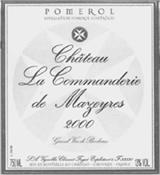
Owner: Clément Fayat
Address: 22 bis, avenue Georges Pompidou, 33500 Libourne
Mailing address: c/o Château La Dominique, 33330 St.-Emilion
Telephone: 05 57 51 31 36; Telefax: 05 57 51 63 04
E-mail: info@vignobles.fayat-group.com
Visits: By appointment Monday to Friday, 9 A.M.–noon and 2–6 P.M.
Contact: Cyril Forget
VINEYARDS
Surface area: 24.7 acres
Grape varietals: 55% Merlot, 45% Cabernet Franc
Average age of vines: 40 years
Density of plantation: 6,000 vines per hectare
Average yields: 40 hectoliters per hectare
Elevage: Thirty day fermentation and maceration in temperature-controlled wooden vats of 70 hectoliter capacity at rather high temperatures and with three to four daily pumpings-over or punching-downs, depending upon the vats. Wines undergo malolactics and are aged 18–22 months in 100% new oak barrels. No fining, no filtration.
WINES PRODUCED
Château La Commanderie de Mazeyres: 12,000 bottles
Château La Closerie de Mazeyres: 25,000–30,000 bottles
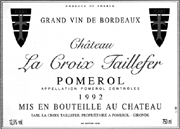
Owner: SARL La Croix Taillefer
Address: Catusseau, 33500 Pomerol
Mailing address: BP 4, 33500 Pomerol
Telephone and Telefax: 05 57 25 08 65
Visits: By appointment only
Contact: Romain Rivière
Surface area: 10.9 acres
Grape varietals: 100% Merlot
Average age of vines: 35 years
Density of plantation: 6,000 vines per hectare
Average yields: 48 hectoliters per hectare
Elevage: Cold maceration, three to four week fermentation and maceration in temperature-controlled stainless-steel tanks. A small part of the yield undergoes malolactics in barrel. Eighteen months aging in new oak. Fining and filtration.
WINES PRODUCED
Château La Croix Taillefer: 22,000 bottles
Château La Loubière: 5,000 bottles
Plateau of maturity: Within 3–10 years of the vintage
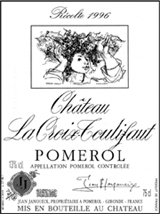
Owner: Joseph Janoueix family
Address: Catusseau, 33500 Pomerol
Mailing address: 37, rue Pline Parmentier, BP 192, 33506 Libourne Cedex
Telephone: 05 57 51 41 86; Telefax: 05 57 51 53 16
E-mail: info@j-janoueix-bordeaux.com
Website: www.j-janoueix-bordeaux.com
Visits: By appointment Monday to Friday, 8 A.M.–noon and 2–6 P.M. (5 P.M. on Fridays)
Contact: Ets Janoueix
VINEYARDS
Surface area: 4 acres
Grape varietals: 85% Merlot, 15% Cabernet Franc
Average age of vines: 45 years
Density of plantation: 6,000 vines per hectare
Average yields: 45 hectoliters per hectare
Elevage: Twenty-five to twenty-seven day fermentation and maceration in temperature-controlled vats. Malolactics and 12–14 months aging in barrels with 80% new oak. Fining, no filtration.
WINES PRODUCED
Château La Croix Toulifaut: 7,200 bottles
No second wine is produced.
Plateau of maturity: Within 5–12 years of the vintage
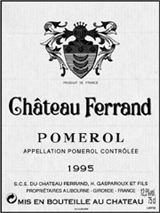
Owner: Henry Gasparoux et fils
Address: lieu-dit Ferrand, 15, chemin de la Commanderie, 33500 Libourne
Telephone: 05 57 51 21 67; Telefax: 05 57 25 01 41
Visits: By appointment only Monday to Friday, 1:30–5 P.M.
Contact: Mrs. Petit
VINEYARDS
Surface area: 29.6 acres
Grape varietals: 50% Cabernet Franc, 50% Merlot
Average age of vines: 34 years
Density of plantation: 5,500 vines per hectare
Average yields: 50 hectoliters per hectare
Elevage: Fermentation and maceration in temperature-controlled stainless-steel vats. Twelve to eighteen months aging in barrels that are renewed by a third at each vintage. Fining and filtration.
WINES PRODUCED
Château Ferrand: 80,000 bottles
No second wine is produced.
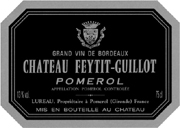
Owner: Irène Lureau/Mrs. Rivière
Address: 34, route de Catusseau, 33500 Pomerol
Telephone: 05 57 51 46 58; Telefax: 05 56 63 19 37
E-mail: feytit-guillot@wanadoo.fr
Visits: By appointment only
Contact: Mrs. Lureau or Mrs. Rivière
VINEYARDS
Surface area: 3.2 acres
Grape varietals: 80% Merlot, 15% Cabernet Franc, 5% Malbec
Average age of vines: 30 years
Density of plantation: 6,000 vines per hectare
Average yields: 50 hectoliters per hectare
Elevage: Fermentation and maceration in concrete tanks. After seven months, wines are aged 12–14 months in barrels that are renewed by a quarter at each vintage. Fining, light filtration upon bottling.
Château Feytit-Guillot: 2,000 bottles
The rest of the production is sold to the Jean-Pierre Moueix firm.
Plateau of maturity: Within 3–10 years of the vintage
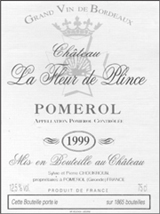
Owner: Pierre and Sylvie Choukroun
Address: Chemin de Plince, 33500 Pomerol
Mailing address: Grand Moulinet, 33500 Pomerol
Telephone: 05 57 74 15 26; Telefax: 05 57 74 15 27
E-mail: gvbpe@wanadoo.fr
Visits: By appointment only
Contact: Pierre Choukroun
VINEYARDS
Surface area: 6.9 acres
Grape varietals: 90% Merlot, 10% Cabernet Franc
Average age of vines: 45 years
Density of plantation: 6,600 vines per hectare
Average yields: 45 hectoliters per hectare
Elevage: Three week fermentation and maceration in stainless-steel vats. Wines undergo malolactics and 14–16 months aging in barrels, with 80% new oak.
WINES PRODUCED
Château La Fleur du Roy: 1,600 bottles
No second wine is produced.
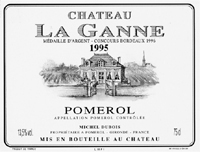
Owner: Paule et Michel Dubois
Address: 224, avenue Foch, 33500 Libourne
Telephone: 05 57 51 18 24; Telefax: 05 57 51 62 20
E-mail: laganne@aol.com
Visits: By appointment only, Monday to Saturday
Contact: Paule Dubois
VINEYARDS
Surface area: 8.6 acres
Grape varietals: 80% Merlot, 20% Cabernet Franc
Average age of vines: 30 years
Density of plantation: 6,000 vines per hectare
Average yields: 38 hectoliters per hectare
Elevage: Five week fermentation and maceration in temperature-controlled tanks. Twelve months aging with 33% new oak. Fining, no filtration.
WINES PRODUCED
Château La Ganne: 15,000 bottles
Vieux Château Brun: 3,000–4,000 bottles
Plateau of maturity: Within 3–10 years of the vintage
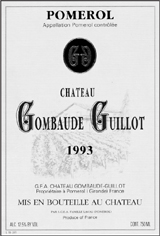
Owner: Claire Laval
Address: 3, Les Grandes Vignes-33500 Pomerol
Telephone: 05 57 51 17 40; Telefax: 05 57 51 16 89
Visits: By appointment only
Contact: Claire Laval
VINEYARDS
Surface area: 17.3 acres
Grape varietals: 65% Merlot, 30% Cabernet Franc, 5% Malbec
Average age of vines: 35 years
Density of plantation: 6,000 vines per hectare
Average yields: 43 hectoliters per hectare
Elevage: Twenty-one to twenty-eight day fermentation in temperature-controlled concrete vats. Twelve to fourteen months aging in barrel (50% new oak). Fining, no filtration.
WINES PRODUCED
Château Gombaude Guillot: 25,000–30,000 bottles
Cadet de Gombaude: 6,000 bottles
Plateau of maturity: Within 5–15 years of the vintage
This has become an intriguing property to follow. I remember tasting the wine in the early 1980s and being unimpressed with the range of vintages I saw from the 1970s, but a vertical tasting back through 1982 left me with the conclusion that in certain years Gombaude Guillot can produce a Pomerol of stunning quality.
The vineyard is comprised of three parcels made up of totally different types of soil. The only parcel from the plateau consists of a heavier soil, dominated by clay and gravel with a great deal of iron in it. A second parcel is primarily sandy soil intermixed with some gravel, and a third parcel consists largely of gravel.
The old vines and relatively low yields that are 30% below many of the more prestigious names often result in strikingly rich, concentrated wines. Interestingly, in 1985, Gombaude Guillot launched a Cuvée Speciale from a selection of wine that represented some of the best lots from their vineyards and aged it in 100% new oak. It was such an enormously successful wine that the château repeated this experiment in 1988 and 1989.
This is not a consistent wine, but when Gombaude Guillot does everything right, it merits attention. The recent vintages, 2001 and 2000, were disappointing.
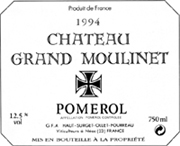
Owner: Jean-Pierre Fourreau
Address: 33500 Néac
Telephone: 05 57 51 28 68; Telefax: 05 57 51 91 79
Visits: Every day of the week, 8 A.M.–noon and 2–6 P.M.
Contact: Jean-Pierre or Patrick Fourreau
VINEYARDS
Surface area: 7.4 acres
Grape varietals: 90% Merlot, 5% Cabernet Franc, 5% Cabernet Sauvignon
Average age of vines: 25 years
Density of plantation: 5,500 vines per hectare
Average yields: 51 hectoliters per hectare
Elevage: Five week fermentation and maceration in temperature-controlled tanks. Twelve months aging in 100% new oak barrels. Fining and filtration if necessary.
WINES PRODUCED
Château Grand Moulinet: 20,000 bottles
Plateau of maturity: Within 3–10 years of the vintage
No second wine is produced.
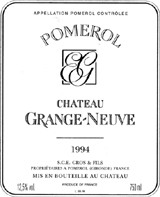
Owner: SGE Gros et Fils
Address: Grange-Neuve, 33500 Pomerol
Telephone: 05 57 51 23 03; Telefax: 05 57 25 36 14
Visits: By appointment only
Contact: Jean-Marie Gros
VINEYARDS
Surface area: 17.3 acres
Grape varietals: 100% Merlot
Average age of vines: 40 years
Density of plantation: 6,700 vines per hectare
Average yields: 45 hectoliters per hectare
Elevage: Fermentations last about a month, with numerous pumpings-over. Wines are transferred to oak casks, which are renewed by a third at each vintage in December (clarification occurs naturally with cold temperatures), and then they are aged for 12–18 months, depending on the vintage. They are fined with egg whites and are bottled after a light filtration.
WINES PRODUCED
Château Grange-Neuve: 30,000 bottles
La Fleur des Ormes: 12,000–13,000 bottles
Plateau of maturity: Within 3–10 years of the vintage
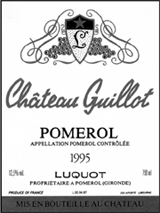
Owner: GFA Lucquot Frères
Address: 22, rue des Grands Champs, 33500 Pomerol
Mailing address: 152, avenue de l’Epinette, 33500 Libourne
Telephone: 05 57 51 18 95; Telefax: 05 57 25 10 59
Visits: By appointment only, on working days
Contact: Jean-Paul Luquot
VINEYARDS
Surface area: 11.6 acres
Grape varietals: 70% Merlot, 30% Cabernet Franc
Average age of vines: 30 years
Density of plantation: 5,900 vines per hectare
Average yields: 48 hectoliters per hectare
Elevage: Four week fermentation and maceration in temperature-controlled concrete tanks. Fifteen months aging in barrels with 40% new oak. Fining, no filtration.
WINES PRODUCED
Château Guillot: 27,000 bottles
No second wine is produced.
Plateau of maturity: Within 3–10 years of the vintage
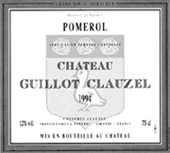
Owner: Mrs. Paul Clauzel
Address: 33500 Pomerol
Telephone: 05 57 51 14 09; Telefax: 05 57 51 57 66
Visits: By appointment only
Contact: Mrs. Paul Clauzel
VINEYARDS
Surface area: 4.2 acres
Grape varietals: 60% Merlot, 40% Cabernet Franc
Average age of vines: 50 and 25 years
Density of plantation: 7,000 vines per hectare
Average yields: 30–35 hectoliters per hectare
Elevage: Fermentations last between 20 and 35 days, depending on the vintage (1992: three weeks; 1995: five weeks) and occur at temperatures of 28–32°C. There are three pumpings-over daily, and malolactics occur in barrels. Wines are brought up in oak barrels, 50–60% of which are new (the rest are one vintage old), for 12–15 months. They are sometimes fined (depending on the vintage), but not filtered.
WINES PRODUCED
Château Guillot Clauzel: 4,200–4,800 bottles
Château Graves Guillot: 3,000–3,600 bottles
Plateau of maturity: Within 3–10 years of the vintage
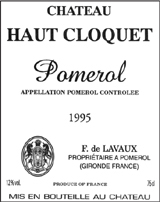
Owner: François de Lavaux
Address: 33500 Pomerol
Mailing address: Établissements Horeau-Beylot, BP125, 33501 Libourne Cedex
Telephone: 05 57 51 06 07; Telefax: 05 57 51 59 61
Visits: By appointment only
Contact: François de Lavaux
VINEYARDS
Surface area: 7.4 acres
Grape varietals: 50% Merlot, 30% Cabernet Sauvignon, 20% Cabernet Franc
Average age of vines: 15–20 years
Density of plantation: 5,500 vines per hectare
Average yields: 40–45 hectoliters per hectare
Elevage: Fermentations and macerations last 18–23 days in temperature-controlled stainless-steel and concrete tanks. Malolactics usually occur in tanks (sometimes a very small percentage of the yield completes this process in oak barrels). Wines are aged for 8–12 months by rotation in oak barrels, 10–15% of which are new (60% of the yield), and concrete tanks (40% of the yield). They are fined and filtered.
WINES PRODUCED
Château Haut Cloquet: 18,000 bottles
No second wine is produced.
Plateau of maturity: Within 3–10 years of the vintage
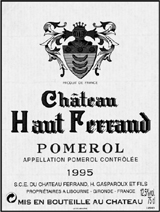
Owner: Henry Gasparoux and Sons
Address: Ferrand, 15, chemin de la Commanderie, 33500 Libourne
Telephone: 05 57 51 21 67; Telefax: 05 57 25 01 41
Visits: By appointment Monday to Friday, 1:30–5 P.M.
Contact: Chantal Petit
VINEYARDS
Surface area: 11.1 acres
Grape varietals: 70% Merlot, 30% Cabernet Franc
Average age of vines: 29 years
Density of plantation: 5,500 vines per hectare
Average yields: 46 hectoliters per hectare
Elevage: Fermentation and maceration in temperature-controlled stainless-steel vats. Fifteen to eighteen months aging in oak barrels that are renewed by a third at each vintage. Fining and filtration.
WINES PRODUCED
Château Haut Ferrand: 20,000 bottles
No second wine is produced.
Plateau of maturity: Within 3–10 years of the vintage
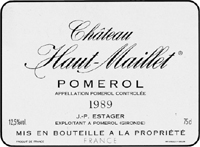
Owner: Estager family
Address: 33500 Pomerol
Mailing address: c/o SCEA Vignobles JP Estager, 33-41, rue de Montaudon, 33500 Libourne
Telephone: 05 57 51 04 09; Telefax: 05 57 25 13 38
E-mail: estager@estager.com
Website: www.estager.com
Visits: By appointment only
Contact: Mrs. Estager
VINEYARDS
Surface area: 12.4 acres
Grape varietals: 80% Merlot, 20% Cabernet Franc
Average age of vines: 23 years
Density of plantation: 5,000 vines per hectare
Average yields: 49 hectoliters per hectare
Elevage: Cold maceration, 3–4 week fermentation and maceration in temperature-controlled stainless-steel tanks. After completion of malolactics in vats, 15–18 months aging in barrels with 40% new oak. Fining, filtration if necessary.
WINES PRODUCED
Château Haut-Maillet: 29,000 bottles
No second wine is produced.
Plateau of maturity: Within 4–10 years of the vintage
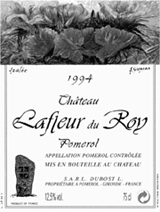
Owner: Yvon Dubost
Address: 13, chemin de Jean Lande, 33500 Pomerol
Telephone: 05 57 51 74 57; Telefax: 05 57 25 99 95
Visits: By appointment only Monday to Friday, 9 A.M.–noon and 2–6 P.M.
Contact: Laurent Dubost
VINEYARDS
Surface area: 7.9 acres
Grape varietals: 85% Merlot, 10% Cabernet Franc, 5% Cabernet Sauvignon
Average age of vines: 40 years
Density of plantation: 5,500 vines per hectare
Average yields: 48 hectoliters per hectare
Elevage: Twenty to twenty-five day fermentation and maceration in temperature-controlled stainless-steel vats at temperatures not exceeding 30°C and with three daily pumpings-over. Fifteen months aging in barrels with 25–30% new oak. Fining with egg whites, no filtration.
WINES PRODUCED
Château Lafleur du Roy: 21,000 bottles
No second wine is produced.
Plateau of maturity: Within 4–10 years of the vintage
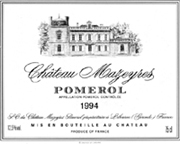
Owner: Caisse de Retraite de la Société Générale
Address: 56, avenue Georges Pompidou, 33500 Libourne
Telephone: 05 57 51 00 48; Telefax: 05 57 25 22 56
E-mail: mazeyres@wanadoo.fr
Website: www.mazeyres.com
Contact: Alain Moueix or Etienne Charrier
VINEYARDS
Surface area: 54.3 acres
Grape varietals: 80% Merlot, 20% Cabernet Franc
Average age of vines: 35+ years
Density of plantation: 6,270 vines per hectare
Average yields: 49 hectoliters per hectare
Elevage: Cold maceration, 3–4 week fermentation and maceration in temperature-controlled stainless-steel tanks of 50–123 hectoliter capacity. Wines undergo malolactics and are aged in barrels with 45% new oak. Light fining with egg whites, no filtration.
WINES PRODUCED
Château Mazeyres: 70,000 bottles
Le Seuil de Mazeyres: 44,000 bottles
Plateau of maturity: Within 3–8 years of the vintage
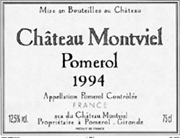
Owner: Catherine Péré-Vergé
Address: Le Grand Moulinet, 33500 Pomerol
Mailing address: 15, rue Henri Dupuis, 62 500 Saint-Omer
Telephone and Telefax: 03 21 93 21 03
E-mail: pvp.montviel@libertysurf.fr
Visits: By appointment only
Contact: Catherine Péré-Vergé
VINEYARDS
Surface area: 19.4 acres
Grape varietals: 75% Merlot, 25% Cabernet Franc
Average age of vines: 30 years
Density of plantation: 6,000 vines per hectare
Average yields: 45 hectoliters per hectare
Elevage: Four week fermentation and maceration. Aging in barrels with 50% new oak.
WINES PRODUCED
Château Montviel: 25,000 bottles
Château La Rose Montviel: 20,000 bottles
Plateau of maturity: Within 5–12 years of the vintage
Owner: GFA du Domaine Moulinet
Address: 33500 Pomerol
Mailing address: Château Fonplégade, 33330 St.-Emilion
Telephone: 05 57 74 43 11; Telefax: 05 57 74 44 67
No visits
VINEYARDS
Surface area: 44.5 acres
Grape varietals: 60% Merlot, 30% Cabernet Sauvignon, 10% Cabernet Franc
Average age of vines: 25 years
Density of plantation: 5,400 vines per hectare
Average yields: 48 hectoliters per hectare
Elevage: Twenty-one day fermentation and maceration in temperature-controlled stainless-steel and concrete vats. Twelve to fifteen months aging in barrels that are renewed by a third at each vintage. No fining, no filtration.
WINES PRODUCED
Château Moulinet: 60,000 bottles
Clos Sainte-Anne: 55,000 bottles
Plateau of maturity: Within 3–15 years of the vintage
GENERAL APPRECIATION
The wines of this underperformer have generally been plain and uninteresting. However, things should improve as the management of the estate has been handed over to the Libourne-based firm of Jean-Pierre Moueix. The first vintages produced under Christian Moueix’s control are considerably better than what has emerged from here over the past years, but there is still much room for improvement.
One of Pomerol’s largest estates, Moulinet is located in the northwest section of the Pomerol appellation near the large estate of de Sales. The soil in this area renders lighter-style Pomerols, and Moulinet is certainly one of the lightest. Unusually light in color and faintly perfumed, the owners make Moulinet in a very commercial style. Starting with the 2000 vintage, Christian Moueix has assumed control over the viticulture and winemaking at this estate, which has had an undistinguished history.
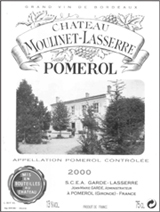
Owner: Jean-Marie Garde
Address: 33500 Pomerol
Telephone: 05 57 51 10 41; Telefax: 05 57 51 16 28
Visits: By appointment only
Contact: Jean-Marie Garde
VINEYARDS
Surface area: 12.4 acres
Grape varietals: 70% Merlot, 20% Cabernet Franc, 10% Malbec
Average age of vines: 35 years
Density of plantation: 5,500 vines per hectare
Average yields: 45 hectoliters per hectare
Elevage: Fermentation and maceration in temperature-controlled concrete tanks. Sixteen months aging in oak barrels that are renewed by a quarter at each vintage. Fining, no filtration.
WINES PRODUCED
Château Moulinet-Lasserre: 25,000 bottles
No second wine is produced.
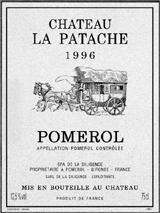
Owner: SARL de La Diligence
Address: La Patache, 33500 Pomerol
Mailing address: BP 78, 33330 St.-Emilion
Telephone: 05 57 55 38 03; Telefax: 05 57 55 38 01
Visits: By appointment Monday to Friday, 9 A.M.–noon and 2–6 P.M.
Contact: Philippe Lauret
VINEYARDS
Surface area: 7.7 acres
Grape varietals: 70% Merlot, 30% Cabernet Franc
Average age of vines: 20 years
Density of plantation: 6,000 vines per hectare
Average yields: 48 hectoliters per hectare
Elevage: Five week fermentation and maceration in temperature-controlled stainless-steel vats. Ten months aging with 50% new oak and 50% one-year-old barrels. Fining, no filtration.
Château La Patache: 20,000 bottles
No second wine is produced.
Plateau of maturity: Within 3–10 years of the vintage
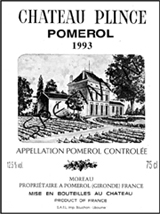
Owner: SCEV Moreau
Address: 33500 Libourne
Telephone: 05 57 51 68 77; Telefax: 05 57 51 43 39
Visits: Preferably by appointment Monday to Friday, 9 A.M.–noon and 2–5 P.M.
Contact: Michel Moreau
VINEYARDS
Surface area: 21.4 acres
Grape varietals: 72% Merlot, 23% Cabernet Franc, 5% Cabernet Sauvignon
Average age of vines: 23 years
Density of plantation: 6,000 vines per hectare
Average yields: 50 hectoliters per hectare
Elevage: Three to four week fermentation in temperature-controlled concrete tanks. Wines undergo malolactics in barrel. Fifteen months aging in barrels that are renewed by a third at each vintage. Fining, no filtration.
WINES PRODUCED
Château Plince: 40,000 bottles
Pavillon Plince: 8,000 bottles
Plateau of maturity: Within 5–10 years of the vintage
GENERAL APPRECIATION
Plince is a pleasant Pomerol, rich and structured, but lacking in finesse and elegance, as well as in the concentration and generosity typical of the best wines of the appellation. In the top vintages, this wine is good but never great, even if the potential of its terroir is fully exploited. Plince is not one of the most expensive Pomerols, but then I do not believe its quality would allow an increase in prices.
Plince is a solid Pomerol, fairly rich, hefty, spicy, deep, and rarely complex, but usually very satisfying. The Moreau family owns this property, but the commercialization is controlled by the Libourne firm of Jean-Pierre Moueix.
I have found Plince to be a consistently sound, well-made wine. Though it may never have the potential to be great, it seems to make the best of its situation. It is a well-vinified wine in a big, chunky style that seems capable of aging for 8–10 years.
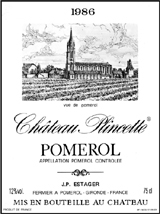
Owner: Estager family
Address: 33500 Pomerol
Mailing address: c/o SCEA des Vignobles JP estager, 33–41, rue de Montaudon, 33500 Libourne
Telephone: 05 57 51 04 09; Telefax: 05 57 25 13 38
E-mail: estager@estager.com
Website: www.estager.com
Visits: By appointment only
Contact: Mrs. Estager
VINEYARDS
Surface area: 3.7 acres
Grape varietals: 83% Merlot, 17% Cabernet Franc
Average age of vines: 32 years
Density of plantation: 5,000 vines per hectare
Average yields: 50 hectoliters per hectare
Elevage: Cold maceration, 3–4 week fermentation and maceration in temperature-controlled vats. After completion of malolactics, 15–18 months aging in barrels with 25% new oak. Fining, filtration if necessary.
WINES PRODUCED
Château Plincette: 10,000 bottles
No second wine is produced.
Plateau of maturity: Within 3–10 years of the vintage
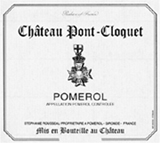
Owner: Stéphanie Rousseau
Address: 1, Petit Sorillon, 33230 Abzac
Telephone: 05 57 49 06 10; Telefax: 05 57 49 38 96
Website: www.vignoblesrousseau.com
Visits: By appointment only.
Contact: Stéphanie Rousseau
VINEYARDS
Surface area: 1.3 acres
Grape varietals: 90% Merlot, 10% Cabernet Sauvignon
Average age of vines: 40 years
Density of plantation: 6,000 vines per hectare
Average yields: 26 hectoliters per hectare
Elevage: Three to four week fermentation. Wines undergo malolactics in barrel. Twelve months aging in 100% new oak. No fining, no filtration.
WINES PRODUCED
Château Pont-Cloquet: 3,500 bottles
No second wine is produced.
Plateau of maturity: Within 3–10 years of the vintage
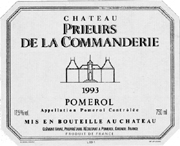
Owner: Clément Fayat
Address: 33500 Pomerol
Mailing address: Château La Dominique, 33330 St.-Emilion
Telephone: 05 57 51 31 36; Telefax: 05 57 51 63 04
E-mail: info@vignobles.fayat-group.com
No visits
VINEYARDS
Surface area: 8.6 acres
Grape varietals: 75% Merlot, 15% Cabernet Franc, 10% Cabernet Sauvignon
Average age of vines: 40 years
Density of plantation: 6,000 vines per hectare
Average yields: 40 hectoliters per hectare
Elevage: Twenty-five to thirty day fermentation and maceration in small temperature-controlled stainless-steel vats with 3–4 daily pumpings over. Eighteen months aging in barrels that are renewed by a third at each vintage. Fining and filtration.
WINES PRODUCED
Château Prieurs de la Commanderie: 12,500 bottles
No second wine is produced.
Plateau of maturity: Within 3–10 years of the vintage
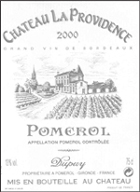
Owner: Indivision Dupuy
Address: 7-8, route de Tropchaud, 33500 Pomerol
Mailing address: c/o Jean-Claude Dupuy, 120, route de St.-Emilion, 33500 Pomerol
Telephone: 06 07 56 75 73; Telefax: 05 57 51 25 44
Visits: By appointment
Contact: Jean-Claude Dupuy
Surface area: 6.5 acres
Grape varietals: 100% Merlot
Average age of vines: 20 years
Density of plantation: 5,800 vines per hectare
Average yields: 35 hectoliters per hectare
Elevage: Eighteen to twenty-five day fermentation and maceration in temperature-controlled stainless-steel vats. Fourteen months aging in oak barrels with 50% new oak. No fining, filtration.
WINES PRODUCED
Château La Providence: 20,000 bottles
Les Chemins de la Providence: 4,000 bottles
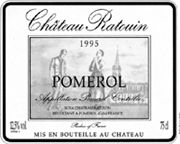
Owner: GFA Famille Ratouin
Address: Village de René, 33500 Pomerol
Telephone: 05 57 51 19 58; Telefax: 05 57 51 47 92
Visits: Preferably by appointment
Contact: Jean-François Beney
VINEYARDS
Surface area: 7.9 acres
Grape varietals: 80% Merlot, 20% Cabernet Franc
Average age of vines: 40 years
Density of plantation: 6,000 vines per hectare
Average yields: 50 hectoliters per hectare
Elevage: Three week fermentation and maceration in temperature-controlled stainless-steel vats. Twelve months aging in barrels that are renewed by a quarter each year. Fining, filtration if necessary.
WINES PRODUCED
Château Ratouin: 16,000 bottles
No second wine is produced.
Plateau of maturity: Within 4–10 years of the vintage
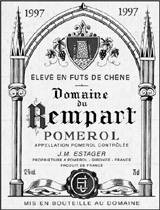
Owner: Paulette Estager
Address: 33500 Pomerol
Mailing address: c/o Vignobles J.-M. Estager, 55, rue des 4 Frères Robert, 33500 Libourne
Telephone: 05 57 51 06 97; Telefax: 05 57 25 90 01
E-mail: vignoblesestager@aol.com
Visits: By appointment only
Contact: Mme. Paganelli-Estager
VINEYARDS
Surface area: 5.4 acres
Grape varietals: 80% Merlot, 20% Cabernet Franc
Average age of vines: 30 years
Density of plantation: 5,500 vines per hectare
Average yields: 46 hectoliters per hectare
Elevage: Twenty-eight day fermentation and maceration in temperature-controlled stainless-steel and concrete vats (28–30°C). Eighteen months aging in French and American oak barrels that are renewed by a third at each vintage. Fining and filtration.
WINES PRODUCED
Domaine du Rempart: 12,300 bottles
No second wine is produced.
Plateau of maturity: Within 3–10 years of the vintage
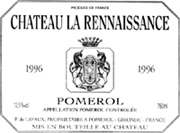
Owner: François de Lavaux
Address: 33500 Pomerol
Mailing address: Établissements Horeau-Beylot, BP125, 33501 Libourne
Telephone: 05 57 51 06 07; Telefax: 05 57 51 59 61
Visits: By appointment only
Contact: François de Lavaux
VINEYARDS
Surface area: 7.4 acres
Grape varietals: 85% Merlot, 15% Cabernet Sauvignon
Average age of vines: 15–25 years
Density of plantation: 5,500 vines per hectare
Average yields: 40 hectoliters per hectare
Elevage: Fermentation and maceration last 18–23 days in temperature-controlled stainless-steel and concrete tanks. Malolactics usually occur in tanks (sometimes a very small percentage of the yield completes this process in oak barrels), and wines are aged for 8–12 months by rotation in oak barrels, 10–15% of which are new (60% of the yield), and concrete tanks (40% of the yield). They are fined and filtered.
WINES PRODUCED
Château La Renaissance: 30,000 bottles
No second wine is produced.
Plateau of maturity: Within 3–10 years of the vintage
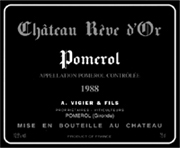
Owner: Maurice Vigier
Address: Cloquet, 33500 Pomerol
Telephone: 05 57 51 11 92; Telefax: 05 57 51 87 70
Visits: By appointment only
Contact: Maurice Vigier
VINEYARDS
Surface area: 17.3 acres
Grape varietals: 80% Merlot, 20% Cabernet Sauvignon
Average age of vines: 40 years
Density of plantation: 5,500 vines per hectare
Average yields: 45 hectoliters per hectare
Elevage: Fermentation and maceration last 3–4 weeks in temperature-controlled stainless-steel tanks. Wines are transferred to oak barrels, 30% of which are new, for 18 months aging. They are fined but not filtered.
WINES PRODUCED
Château Rêve d’Or: 18,000 bottles
Château du Mayne: 18,000 bottles
Plateau of maturity: Within 3–10 years of the vintage
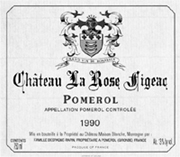
Owner: GFA Despagne-Rapin
Address: 33500 Pomerol
Mailing address: Maison-Blanche, 33570 Montagne
Telephone: 05 57 74 62 18; Telefax: 05 57 74 58 98
Visits: By appointment only
Contact: Gérard Despagne
Surface area: 13.6 acres (2.5 acres in the very northern part of Pomerol and 11.1 acres in the extreme south of the appellation)
Grape varietals: 85% Merlot, 15% Cabernet Franc
Average age of vines: 40 years
Density of plantation: 5,350 vines per hectare
Average yields: 50 hectoliters per hectare
Elevage: Fermentations last 15–20 days in epoxy-lined vats. Wines are then transferred for 12–15 months aging in new oak barrels. They are fined and filtered.
WINES PRODUCED
Château La Rose Figeac: 15,000 bottles
Château Hautes Graves Beaulieu: 3,000–4,000 bottles
Plateau of maturity: Within 3–10 years of the vintage
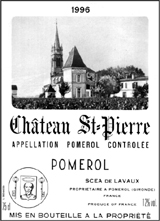
Owner: De Lavaux family
Address: 33500 Pomerol
Mailing address: Établissements Horeau-Beylot, BP125, 33501 Libourne
Telephone: 05 57 51 06 07; Telefax: 05 57 51 59 61
Visits: By appointment only
Contact: Mme. Dubreuil-Lureau
VINEYARDS
Surface area: 7.4 acres
Grape varietals: 65% Merlot, 20% Cabernet Franc, 15% Cabernet Sauvignon
Average age of vines: 35 years
Density of plantation: 5,500 vines per hectare
Average yields: 30–40 hectoliters per hectare
Elevage: Fermentations and macerations last 18–23 days in temperature-controlled stainless-steel and concrete tanks. Malolactics usually occur in tanks. Wines are aged for 8–12 months by rotation in concrete tanks for 40% of the yield and in oak barrels (10–15% of which are new) for the rest. They are fined and filtered.
WINES PRODUCED
Château St.-Pierre: 15,000–18,000 bottles
No second wine is produced.
Plateau of maturity: Within 3–10 years of the vintage
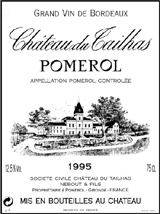
Owner: SC Château du Tailhas
Address: route de Saint-Emilion, 33500 Pomerol
Telephone: 05 57 51 26 02; Telefax: 05 57 25 17 70
Visits: By appointment only
Contact: Anne-Marie Sublett
VINEYARDS
Surface area: 27.2 acres
Grape varietals: 80% Merlot, 10% Cabernet Franc, 10% Cabernet Sauvignon
Average age of vines: 35 years
Density of plantation: 5,500 vines per hectare
Average yields: 40 hectoliters per hectare
Elevage: Cold maceration, three week fermentation and maceration in temperature-controlled concrete tanks. Wines undergo malolactics in barrel. Twelve months aging, half in barrels (50% new oak) and half in concrete tanks. Fining and filtration.
WINES PRODUCED
Château Tailhas: 40,000 bottles
La Garenne: 20,000 bottles
Plateau of maturity: Within 3–10 years of the vintage
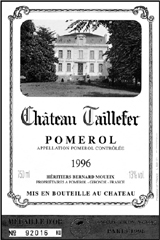
Owner: Heirs of Bernard Moueix
Address: 33500 Libourne
Mailing address: BP 9, 33501 Libourne Cedex
Telephone: 05 57 25 50 45; Telefax: 05 57 25 50 45
Visits: By appointment only
Contact: Catherine Moueix
VINEYARDS
Surface area: 28.4 acres
Grape varietals: 75% Merlot, 25% Cabernet Sauvignon
Average age of vines: 30 years
Density of plantation: 6,000 vines per hectare
Average yields: 45 hectoliters per hectare
Elevage: Three to four week fermentation and maceration in temperature-controlled concrete tanks. Fifteen months aging in barrels with 33% new oak. Fining and filtration.
Château Taillefer: 48,000 bottles
Château Fontmarty: 21,000 bottles
Plateau of maturity: Within 3–10 years of the vintage
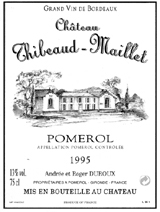
Owner: Roger and Andrée Duroux
Address: 33500 Pomerol
Telephone: 05 57 51 82 68; Telefax: 05 57 51 58 43
Visits: By appointment
Contact: Roger and Andrée Duroux
VINEYARDS
Surface area: 3 acres
Grape varietals: 90% Merlot, 10% Cabernet Franc
Average age of vines: 25 years
Density of plantation: 5,000 vines per hectare
Average yields: 45–50 hectoliters per hectare
Elevage: Three to four week fermentation and maceration in temperature-controlled vats. Twelve to fourteen months aging with 50% new oak and 50% one-year-old barrels. Fining, filtration if necessary.
WINES PRODUCED
Château Thibeaud-Maillet: 6,000 bottles
Plateau of maturity: Within 3–10 years of the vintage
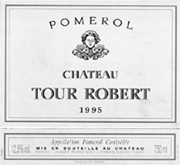
Owner: Dominique Leymarie
Address: 11 chemin de Grangeneuve, 33500 Libourne
Mailing address: c/o Dominique Leymarie, BP 132, 90, avenue Foch, 33502 Libourne Cedex
Telephone: 05 57 51 97 83; Telefax: 05 57 51 99 94
E-mail: leymarie@ch-leymarie.com
Visits: By appointment only
Contact: Dominique Leymarie
VINEYARDS
Surface area: 11.7 acres
Grape varietals: 75% Merlot, 20% Cabernet Franc, 5% Cabernet Sauvignon
Average age of vines: 35 years
Density of plantation: 6,500 vines per hectare
Average yields: 41 hectoliters per hectare
Elevage: Thirty-plus day fermentation and maceration in temperature-controlled concrete vats. Part of the yield undergoes malolactics in barrel. Sixteen to eighteen months aging in barrels with 67% new oak. No fining, light filtration upon bottling.
WINES PRODUCED
Château Tour Robert: 7,000 bottles
Château Robert: 18,000 bottles
Plateau of maturity: Within 3–10 years of the vintage
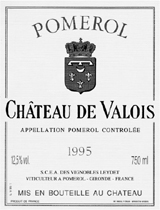
Owner: Frédéric Leydet
Address: Rouilledirat, 33500 Libourne
Telephone: 05 57 51 19 77; Telefax: 05 57 51 00 62
E-mail: frederic.leydet@wanadoo.fr
Visits: Monday to Friday, 9 A.M.–6 P.M. By appointment on Sundays.
Contact: Frédéric Leydet (Mobile: 06 08 93 10 03)
VINEYARDS
Surface area: 18.9 acres
Grape varietals: 77% Merlot, 19% Cabernet Franc, 4% Cabernet Sauvignon
Average age of vines: 30 years
Density of plantation: 5,800 vines per hectare
Average yields: 50–53 hectoliters per hectare
Elevage: Four to six week fermentation and maceration at 28–32°C with frequent pumpings-over. Eleven to fifteen months aging in barrels with 50% new oak. Fining and filtration.
WINES PRODUCED
Château de Valois: 30,000–35,000 bottles
Château La Croix Saint-Vincent: 15,000–20,000 bottles
Plateau of maturity: Within 3–10 years of the vintage

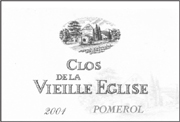
Owner: Jean-Louis Trocard
Address: 33500 Pomerol
Mailing address: BP 3, 33570 Les Artigues-de-Lussac
Telephone: 05 57 55 57 90; Telefax: 05 57 55 57 98
E-mail: trocard@wanadoo.fr
Website: www.trocard.com
Visits: Monday to Friday, 8 A.M.–noon and 2–5:30 P.M. By appointment on weekends.
Contact: Benoît Trocard
VINEYARDS
Surface area: 3.7 acres
Grape varietals: 90% Merlot, 10% Cabernet Sauvignon
Average age of vines: 40 years
Density of plantation: 6,500 vines per hectare
Average yields: 45 hectoliters per hectare
Elevage: Three week maceration and fermentation. Eighteen months aging in new oak. Fining and filtration.
WINES PRODUCED
Clos de la Vieille Église: 6,500 bottles
No second wine is produced.
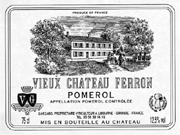
Owner: EARL Vignobles Garzaro
Address: 36, route de Montagne, 33500 Libourne
Mailing address: Château Le Prieur, Les vins Garzaro, 33750 Baron
Telephone: 05 56 30 16 16; Telefax: 05 56 30 12 63
E-mail: garzaro@vingarzaro.com
Website: www.vingarzaro.com
Visits: By appointment only
Contact: Elie Garzaro
VINEYARDS
Surface area: 9.9 acres
Grape varietals: 90% Merlot, 5% Cabernet Franc, 5% Petit Verdot
Average age of vines: 30–40 years
Density of plantation: 7,200 vines per hectare
Average yields: 47 hectoliters per hectare
Elevage: Three week fermentation and maceration in temperature-controlled vats. Twelve to eighteen months aging in 100% new oak barrels. Fining with egg whites, no filtration.
WINES PRODUCED
Château Vieux Ferron: 10,000 bottles
Clos des Amandiers: 15,000 bottles
Plateau of maturity: Within 3–10 years of the vintage
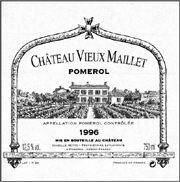
Owner: Isabelle Motte
Address: 8, route de Maillet, 33500 Pomerol
Telephone: 05 57 51 04 67; Telefax: 05 57 51 04 67
E-mail: chateau.vieux.maillet@wanadoo.fr
Visits: By appointment only
Contact: Isabelle Motte
VINEYARDS
Surface area: 6.5 acres
Grape varietals: 80% Merlot, 20% Cabernet Franc
Average age of vines: 35 years
Density of plantation: 5,600 vines per hectare
Average yields: 40 hectoliters per hectare
Elevage: Three to four week fermentation and maceration in temperature-controlled concrete vats. Wines undergo malolactics in barrel. Twelve to fourteen months aging with 80% new oak, frequent stirring of the lees and two rackings. Fining, no filtration.
WINES PRODUCED
Château Vieux Maillet: 12,000 bottles
No second wine is produced.
Plateau of maturity: Within 3–10 years of the vintage
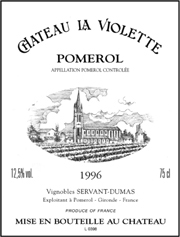
Owner: SCI Vignobles Servant-Dumas
Address: Catusseau, 33500 Pomerol
Mailing address: 1, Moulin Rouge, 33141 Villegouge
Telephone: 05 57 55 54 60; Telefax: 05 57 55 54 64
E-mail: servant-dumas@wanadoo.fr
Visits: By appointment only
Contact: Jean-Pierre Dumas
Surface area: 11.1 acres
Grape varietals: 80% Merlot, 20% Cabernet Sauvignon
Average age of vines: 25 years
Density of plantation: 6,000 vines per hectare
Average yields: 40 hectoliters per hectare
Elevage: Ten months aging in barrels and vats. Fining and filtration.
WINES PRODUCED
Château La Violette: 22,000 bottles
No second wine is produced.
Plateau of maturity: Within 5–15 years of the vintage
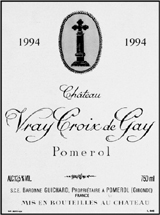
Owner: Olivier Guichard
Address: 33500 Pomerol
Mailing address: c/o SCE Baronne Guichard, Château Siaurac, 33500 Néac
Telephone: 05 57 51 64 58; Telefax: 05 57 51 41 56
Visits: By appointment only
Contact: Yannick Reyrel
VINEYARDS
Surface area: 9.1 acres
Grape varietals: 85% Merlot, 15% Cabernet Franc
Average age of vines: 35 years
Density of plantation: 6,000 vines per hectare
Average yields: 45 hectoliters per hectare
Elevage: Three to four week fermentation and maceration in temperature-controlled stainless-steel tanks. Fourteen to eighteen months aging in barrels with 30% new oak. Fining and filtration.
WINES PRODUCED
Château Vray Croix de Gay: 15,000 bottles
No second wine is produced.
Plateau of maturity: Within 5–15 years of the vintage
St.-Emilion is Bordeaux’s most aesthetically pleasing tourist attraction. Some will even argue that the walled, medieval village of St.-Emilion, perched on several hills amid a sea of vines, is France’s most beautiful wine town. It is also the epicenter of a Bordeaux revolution, the so-called “garage wine movement” that will be discussed later. This is the largest serious red wine appellation of Bordeaux, encompassing more than 13,434 acres.
The wine community of St.-Emilion is a very closely knit fraternity that maintains a fierce belief that their wines are the best in Bordeaux. They have always felt slighted because the region was entirely omitted from the 1855 Classification of the Wines of Gironde.
St.-Emilion is only a forty-minute drive east from Bordeaux. Pomerol sits to the north, and the obscure satellite appellations of Montagne, Lussac, Puisseguin, and St.-Georges St.-Emilion, as well as the Côtes de Francs and the increasingly fashionable Côtes de Castillon, border it on the east and south. The top vineyards are centered in distinctive and geographically different parts of St.-Emilion. Historically, St.-Emilion’s finest wines have tended to emerge from vineyards planted on the limestone plateau, the limestone hillsides (the so-called côtes), and the gravel terraces adjacent to Pomerol. Yet the decade of the 1990s has established that historically obscure and lowly regarded terroirs, if managed by perfectionist proprietors who practice extreme viticulture, can produce exceptionally fine wines. These are the controversial “garage wines.”
The vineyards called “côtes St.-Emilions” cover the limestone hillsides that surround much of the walled town of St.-Emilion. There are even a few vineyards located within St.-Emilion. Most of St.-Emilion’s best known wines—Ausone, both Beauséjours, Belair, Canon, Magdelaine, L’Arrosée, and Pavie—are located along these hillsides. Of the official 13 premier grand cru properties of St.-Emilion (the most recent classification took place in 1996), 10 have at least part of their vineyards on these limestone hillsides. The wines from the côtes vineyards are all unique and distinctive, but they share a firm, restrained, more austere character in their youth. However, with proper aging, as a general rule the youthful toughness gives way to wines of richness, power, and complexity.
Certainly Ausone, with its impressive wine cellars carved out of the rocky hillside and its steep vineyard filled with very old, gnarled vines, is the most famous wine of the St.-Emilion côtes. This property was considered capable of making one of Bordeaux’s best wines in the 19th century, but much of the 20th-century wine of Ausone was surprisingly undistinguished. Ausone tends to be different from the other côtes St.-Emilions. Tougher, more tannic, with an exotic, sweet bouquet, it has more of a Médoc austerity on the palate than many of its neighbors. In 2001, 2000, 1999, 1998, 1996, 1995, 1990, 1989, 1988, 1983, and 1982 the château produced magnificent wines. Yet internal bickering between the two families that shared ownership, Vauthier and Dubois-Challon, led to legal friction, with Alain Vauthier and his family buying out the interest of Madame Dubois-Challon. This has led to some significant changes in the winemaking philosophy, particularly evident with all vintages since 1995.